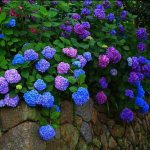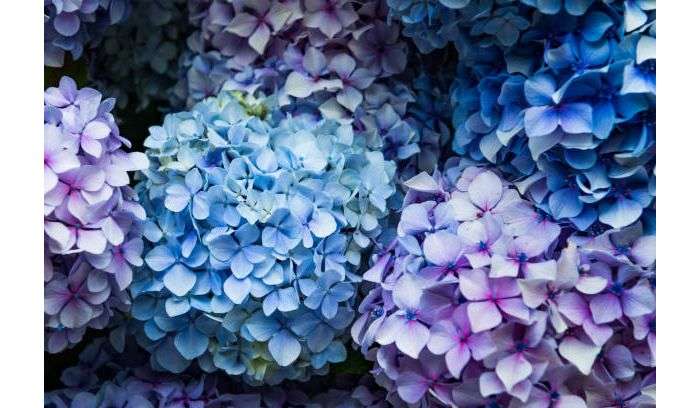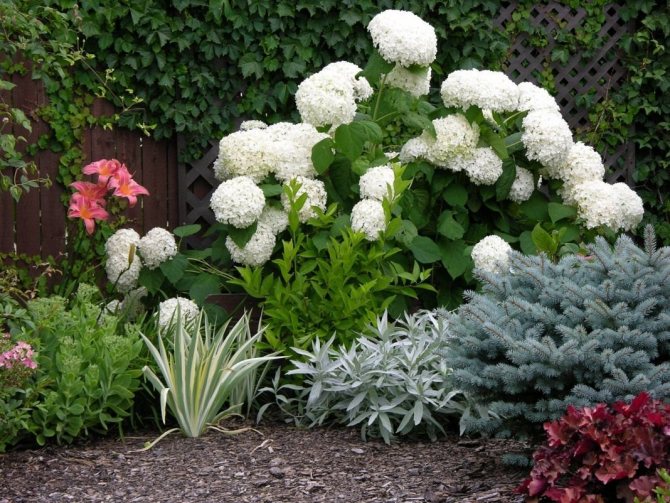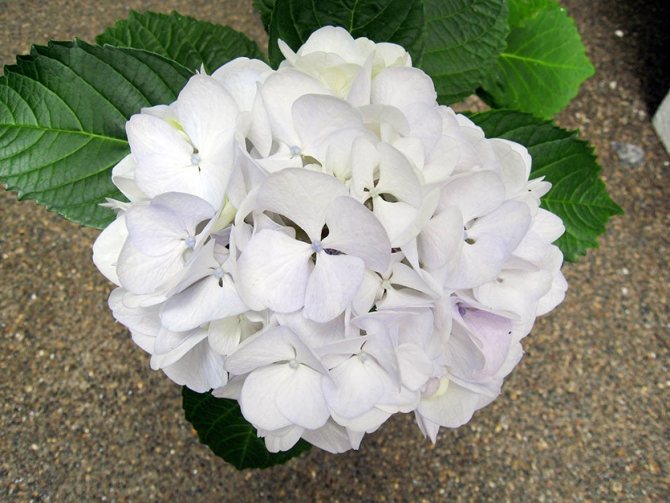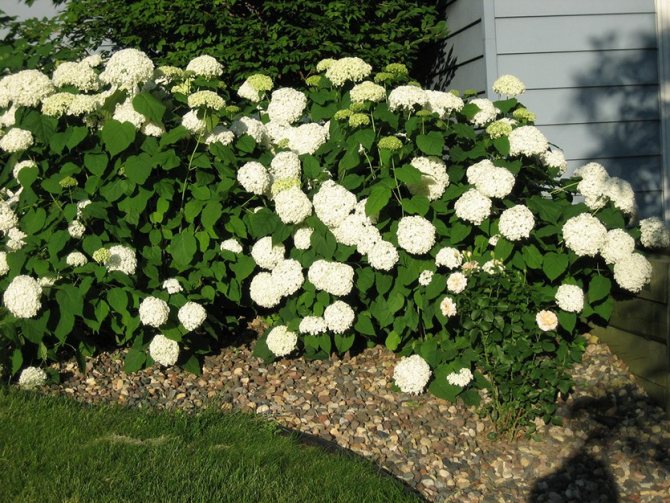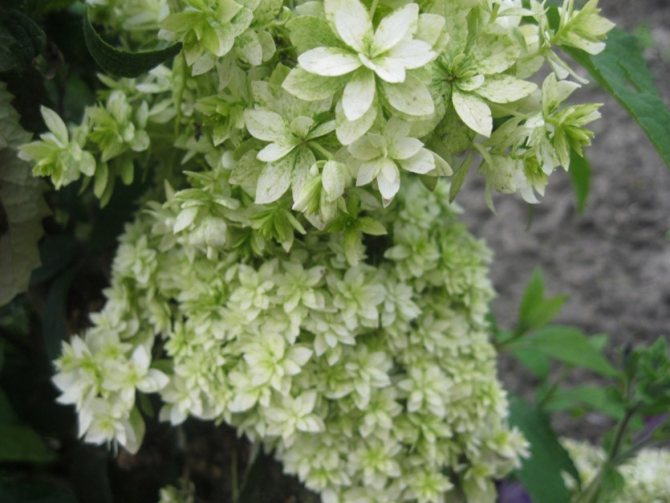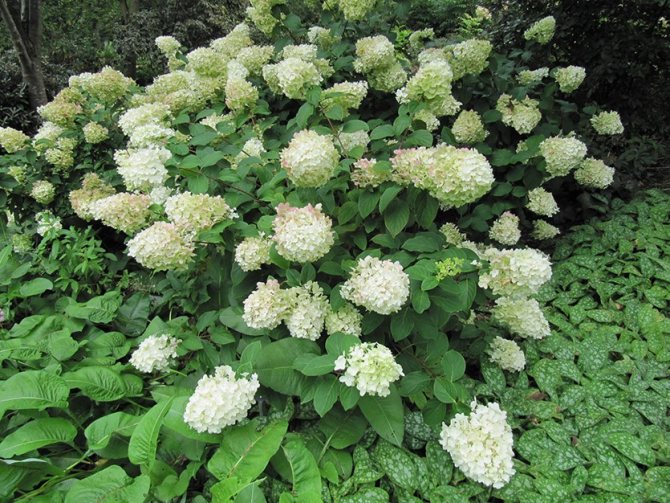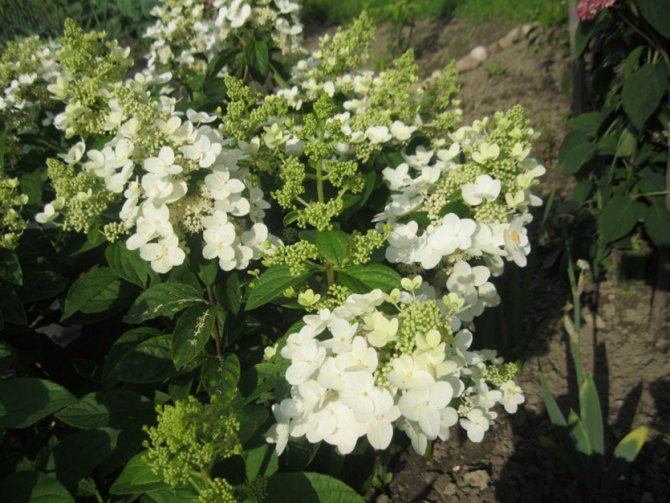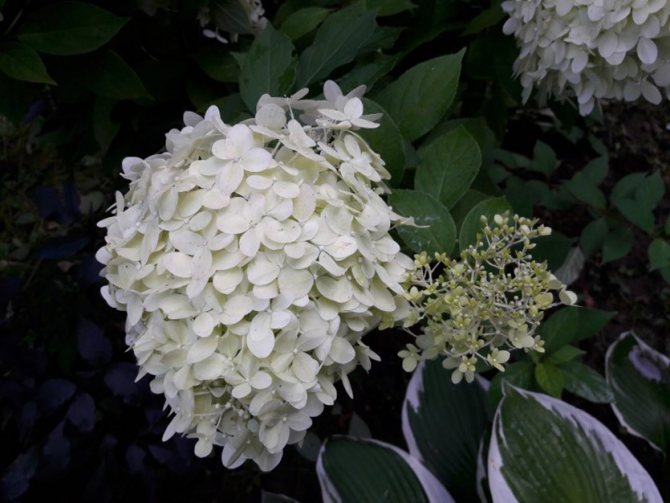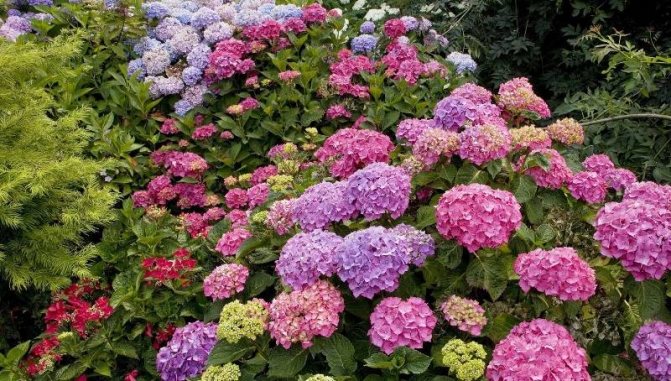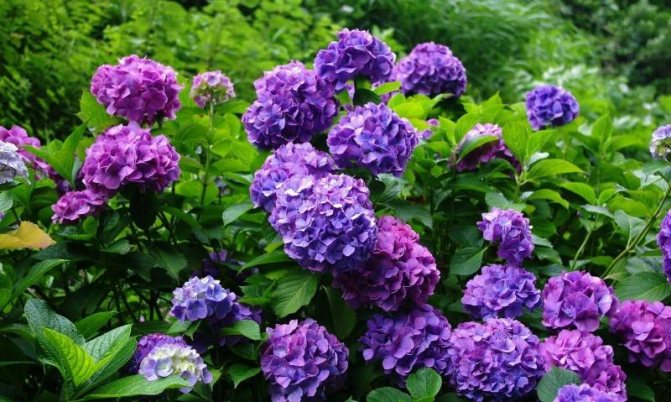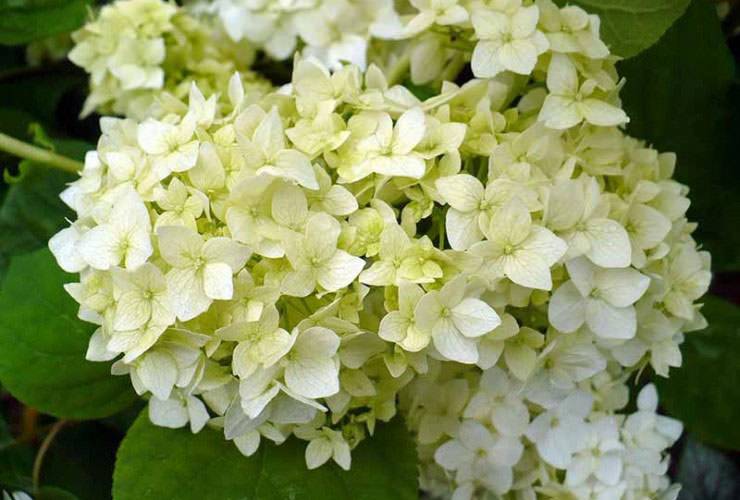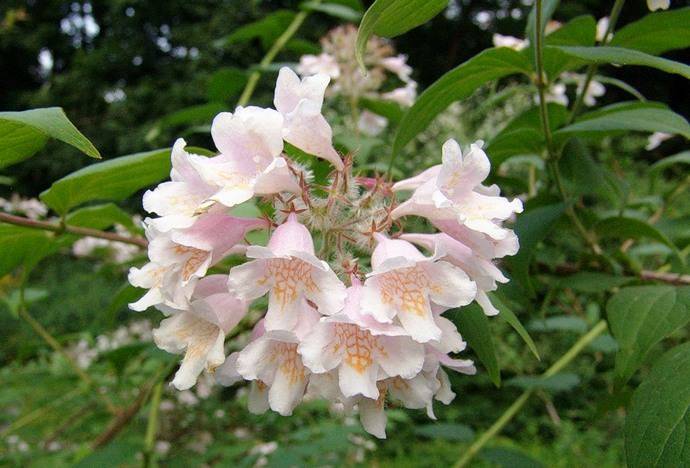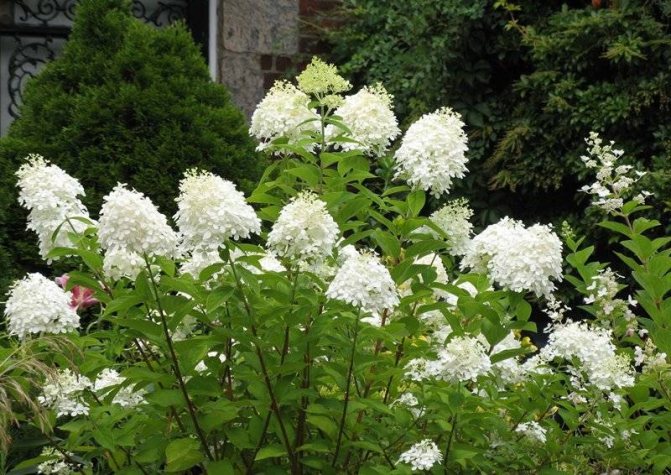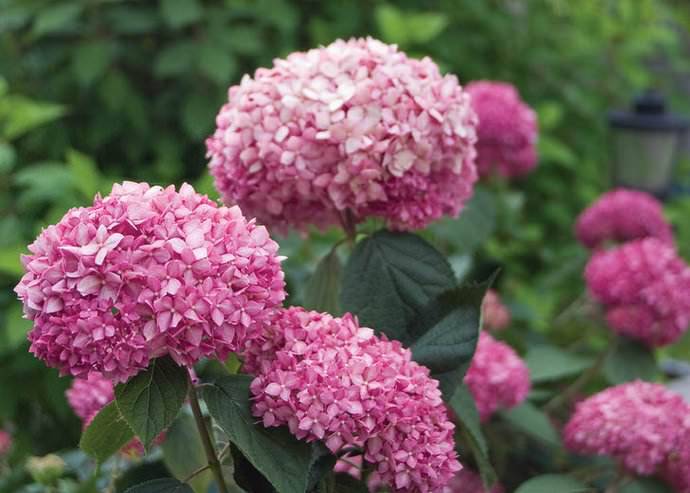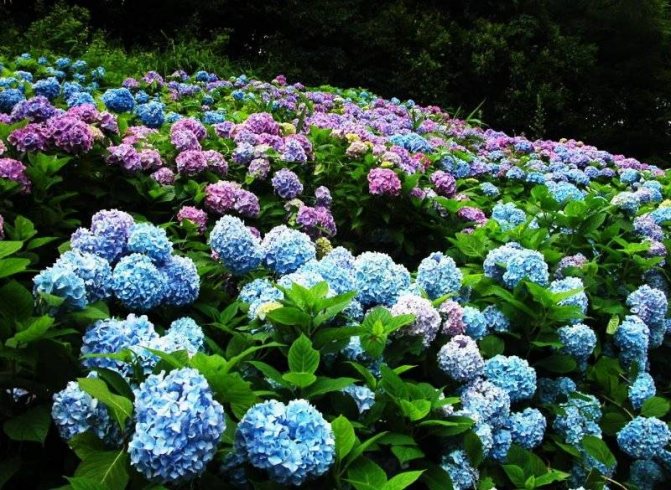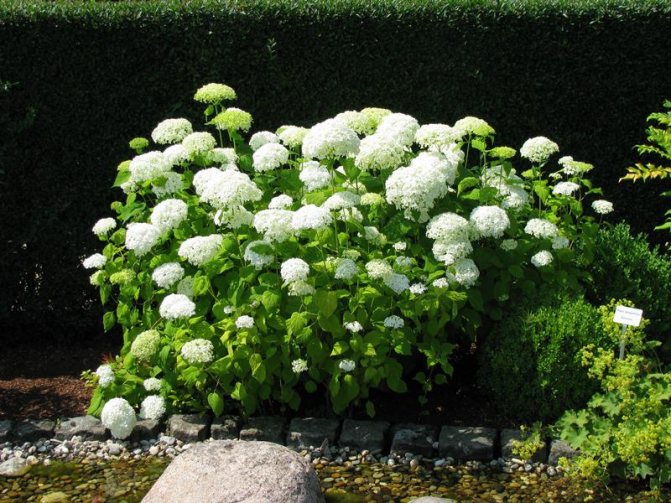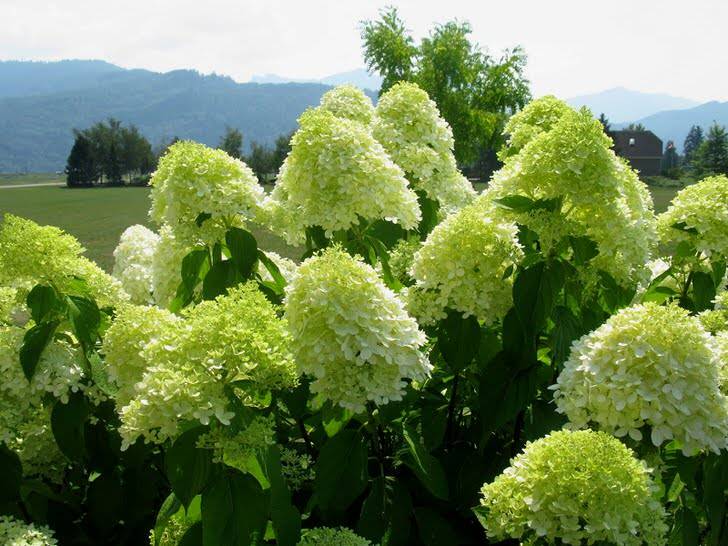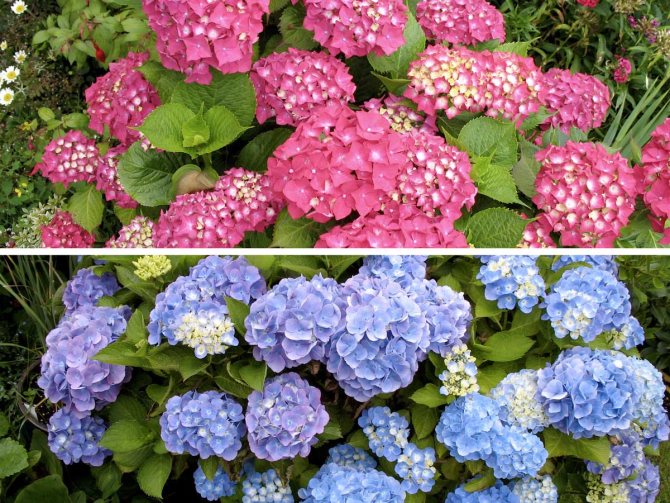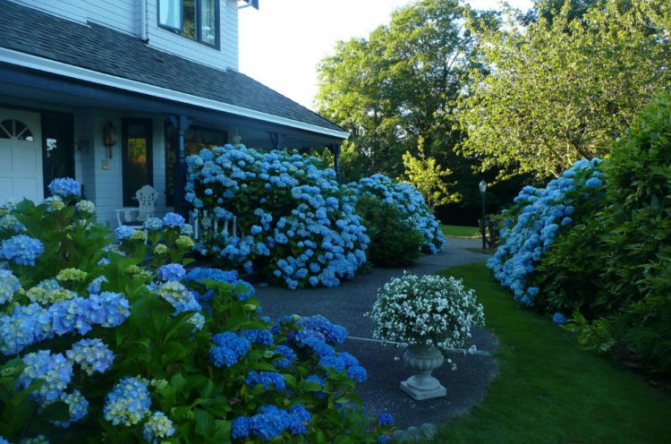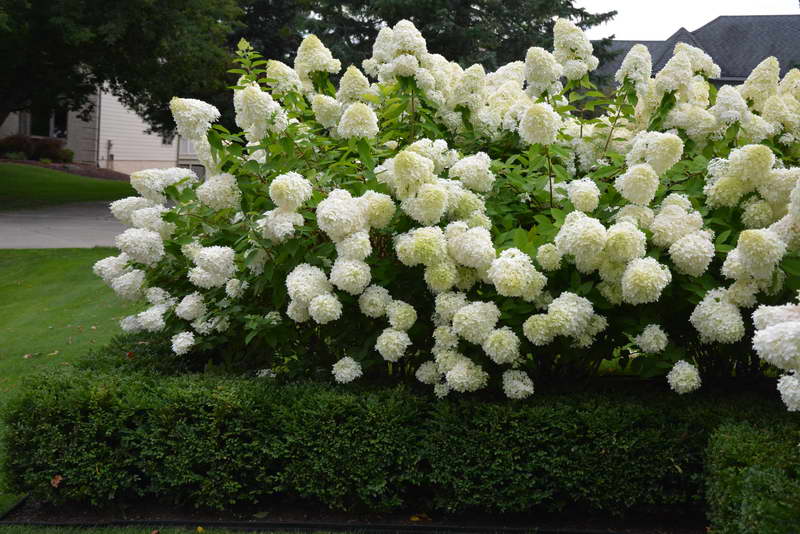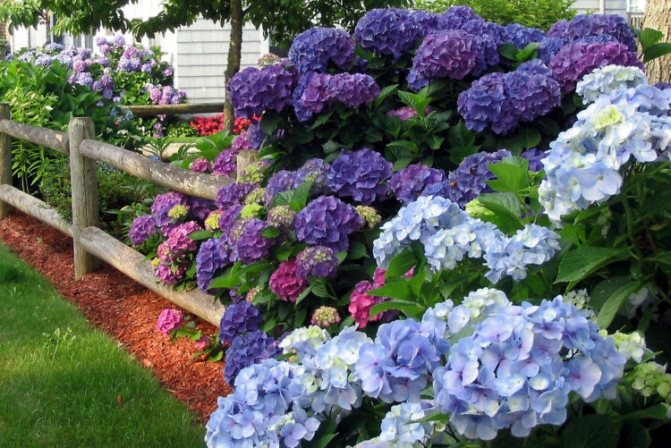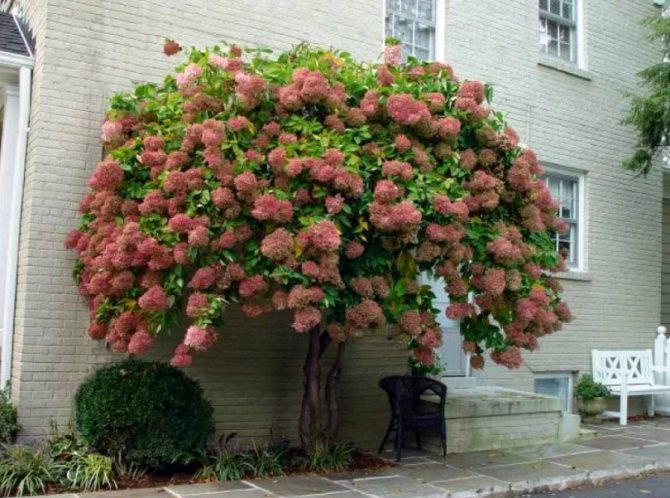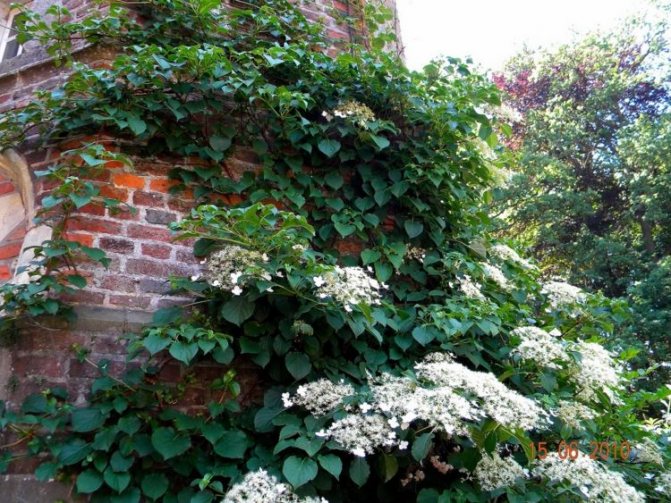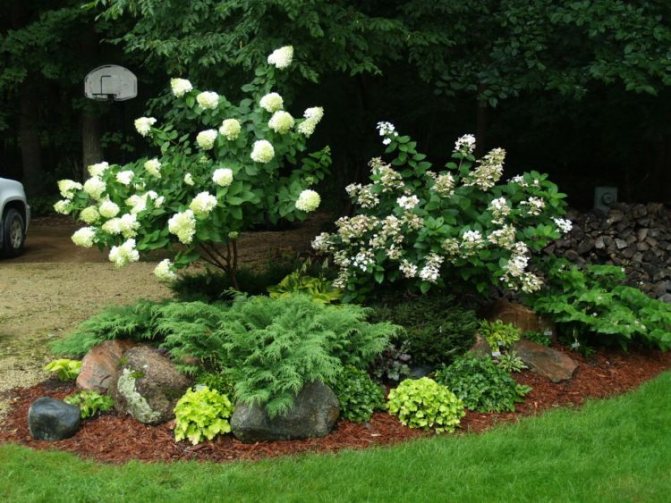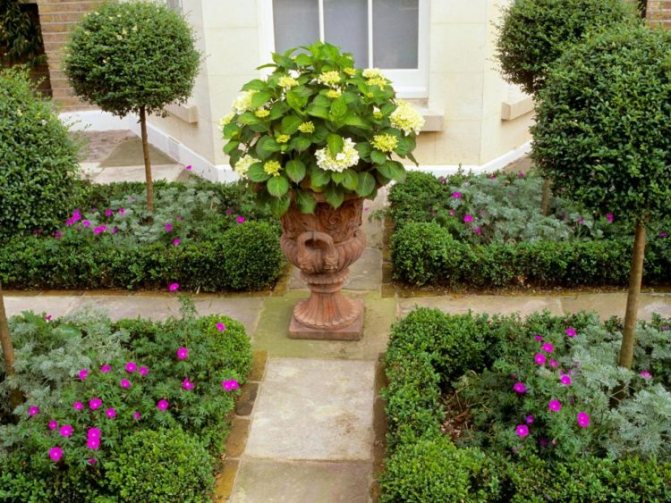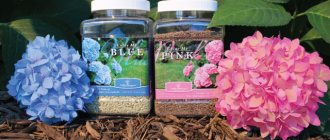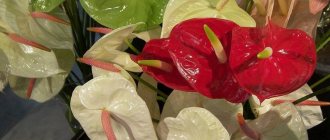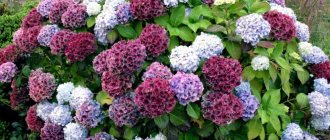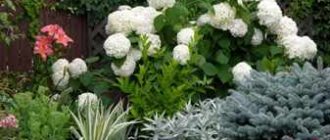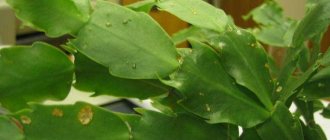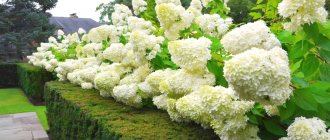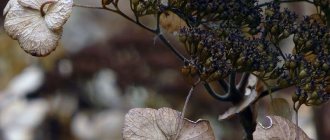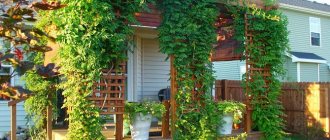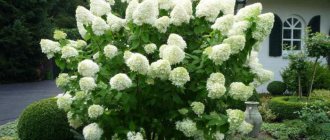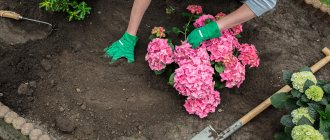Hydrangeas are shrubs of amazing beauty and variety.
1:665 1:675
In gardening, hydrangeas are valued for a variety of inflorescence shapes, an extensive palette of flowers, large curly leaves, interesting bark, as well as for their unpretentiousness and abundant flowering. An unusually spectacular sight of hydrangeas is presented in the fall, when on one plant you can simultaneously see buds, seed heads and leaves of different colors.
1:1303 1:1313 1:1436 1:1440 1:1450
The botanical name of the shrub - hydrangea - is known only to specialists. Meanwhile, translated from Greek, it means "a vessel with water" and speaks of a very important quality of a plant - it loves moisture very much.
1:1854 1:9

2:514 2:524
Most species are shrubs 1-3 m high, some species are small trees, the rest - vinesclimbing along the trunks of other trees to a height of up to 30 m.
2:853 2:863
Plants can be either deciduous or evergreen, however, the widely cultivated species of the temperate zone are deciduous.
2:1118 2:1128
Hydrangeas bloom from spring to late autumn. Flowers are collected at the end of the stem in beautiful spherical inflorescences - a scutellum or panicle.
2:1372
In most species, flower heads contain two types of flowers: small fertile (fertile) flowers in the middle and large sterile (sterile) flowers at the edges. In some species, all flowers are fertile and have the same size.
2:1797 2:9
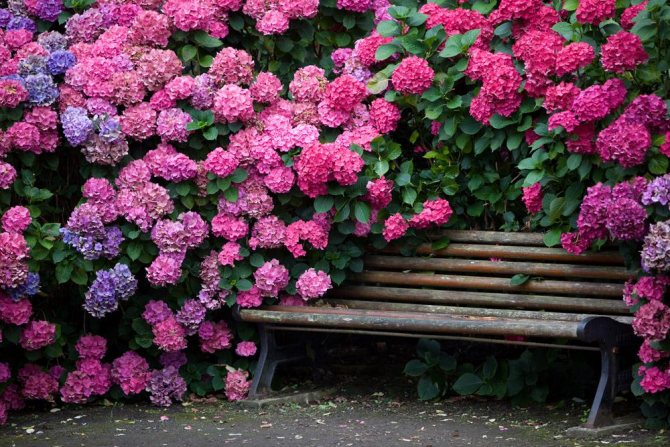

3:514 3:524
The vast majority of hydrangea flowers are white, but in some, such as the large-leaved hydrangea (Hydrangea macrophylla), they can be blue, red, pink and lilac.
3:849 3:859
In these species, the color often depends on the pH (pH) level in the soil: in acidic soils, the petals become blue, in neutral soils - pale beige, and in alkaline soils - pink or lilac.
3:1238 3:1248
Hydrangeas are one of the few plants that can accumulate aluminum in themselves, which is released from acidic soils and in some species forms compounds that give them blue tints.
3:1584 3:9
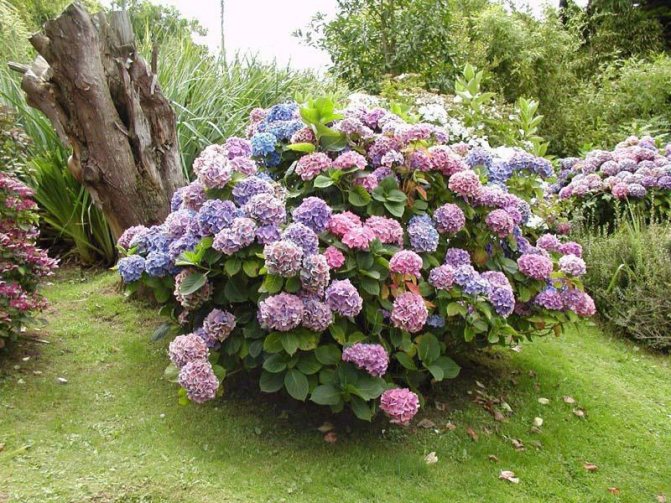

4:514 4:524 4:584
The total number of species is from 70 to 80, we list here only the main ones.
4:716 4:726
General information about the plant
The name "hydrangea" was given to the plant in honor of Princess Hortense - sister of the Prince of the Holy Roman Empire Carl Heinrich of Nassau-Siegen. The botanical name of the shrub - "hydrangea" - is known only to specialists. Meanwhile, translated from Greek, it means "a vessel with water" and speaks of a very important quality of a plant - it loves moisture very much.
The vast majority of hydrangea species are shrubs with a height of 1-3 m, but some species are small trees, the rest are lianas climbing the trunks of other trees to a height of up to 30 m.Plants can be both deciduous and evergreen, but widely cultivated species of the temperate zone are deciduous.
Hydrangeas bloom from spring to late autumn. Flowers are collected at the end of the stem in beautiful spherical inflorescences - a scutellum or panicle. In most species, flower heads contain two types of flowers: small fertile (fertile) flowers in the middle and large sterile (sterile) flowers at the edges. In some species, all flowers are fertile and have the same size.
The vast majority of hydrangea flowers are white, but some, such as large-leaved hydrangea (Hydrangea macrophylla), they can be blue, red, pink and lilac. In these species, the color often depends on the pH (hydrogen index) level in the soil: in acidic soils, the petals become blue, in neutral soils - pale beige, and in alkaline soils - pink or lilac. Hydrangeas are one of the few plants capable of accumulating aluminum, which is released from acidic soils and in some species forms compounds that give them blue tints.
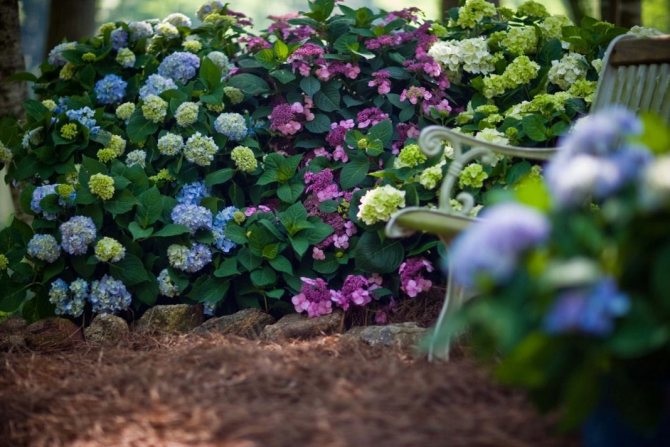

A corner of the garden with hydrangeas. <>
Why do hydrangeas have small inflorescences? The plant needs rejuvenation
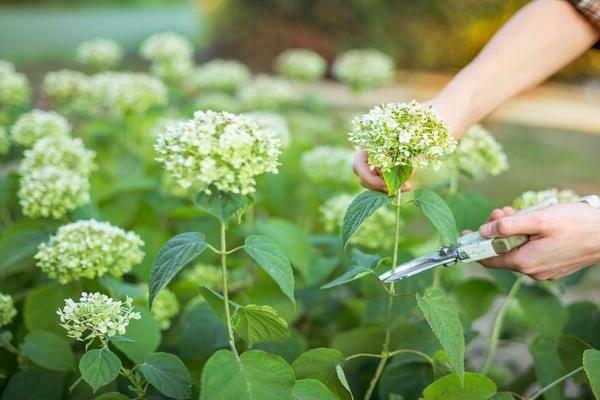

Hydrangea is a perennial plant and in order for it to demonstrate all its beauty for many years, it is necessary to carry out the rejuvenation procedures correctly.
In addition to the fact that shoots are removed during pruning, flowers must be removed, but taking into account some nuances:
- A flower that was released in the first year of life is removed, since the buds take up a large amount of strength that the root system needs in order to strengthen well.
- In all other periods, the removal of flowers is not required, only those that have faded and died off.
- The panicles are cut off when they begin to bloom. This will help the plant to release new shoots before the first frosts begin.
Often novice gardeners ask themselves how the removal of the first flowers will affect flowering, and whether this should be done.
Most experienced gardeners insist that after removing the first flowers, the growth of flowers will begin much more actively and better. They recommend shooting 1/3 of the colors that appear first.
In order that you are no longer tormented by the question associated with poor-quality flowering of small inflorescences, follow the rules that were described above. A beautiful lush flowering will turn out only by spending some time on these beauties, and this already depends only on the owner on the site.
a source
The main types of hydrangeas
Hydrangea (Hydrangea) is a genus of flowering plants of the family Hortensiae, consisting of about 70-80 species, we list here only the main ones.
Hydrangea tree (Hydrangea arborescens)
A species that naturally grows in the east of North America. Inflorescences are white. Blooms in July-August. In late autumn, it is recommended to cut off the faded inflorescences. Pruning of frozen, thickened and weakened shoots should be carried out either before the start of sap flow, or after the leaves have completely bloomed. One of the famous varieties - Hydrangea arborescens 'Annabelle' with dark leaves and very large greenish inflorescences.
Read our detailed article: Rules for growing tree hydrangeas.
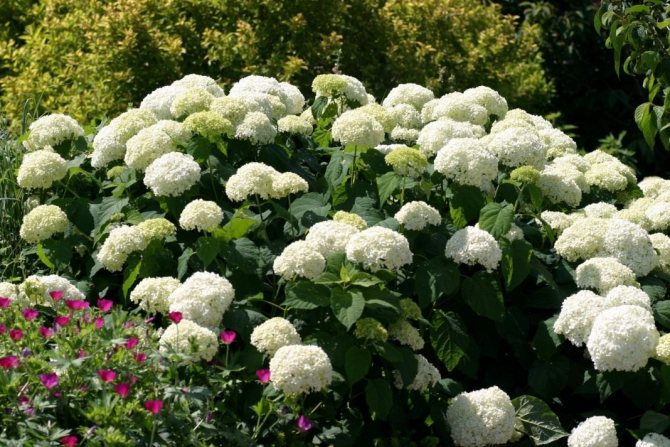

Treelike hydrangea (Hydrangea arborescens).
Hydrangea bretschneideri
View from China. Large shrub up to two and a half meters high. The leaves are large, oval, dark green. Inflorescences are wide scutes. Blooms from early July; at the beginning of flowering, the flowers are white, by the end of July they turn pink, and in August they acquire a rich crimson color. In the conditions of the European part of Russia, the plant does not require shelter for the winter.
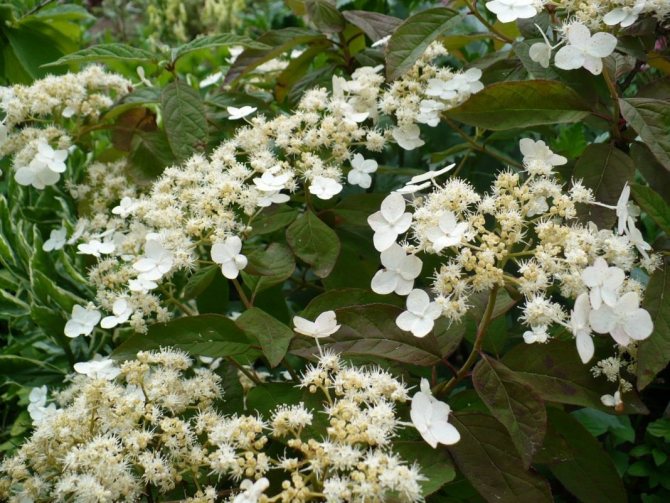

Hydrangea bretschneideri. <>
Large-leaved hydrangea (Hydrangea macrophylla)
View from South Japan. The leaves are bright green, large. The inflorescences are lilac, bloom in August. Low winter hardiness; in the conditions of the European part of Russia, only some particularly cold-resistant varieties do not freeze, - for example, Hydrangea macrophylla ‘Blue Wave’ and ‘Endless Summer’. This species is also grown as a houseplant.
Read our detailed article: The best varieties of large-leaved hydrangeas for the middle lane.
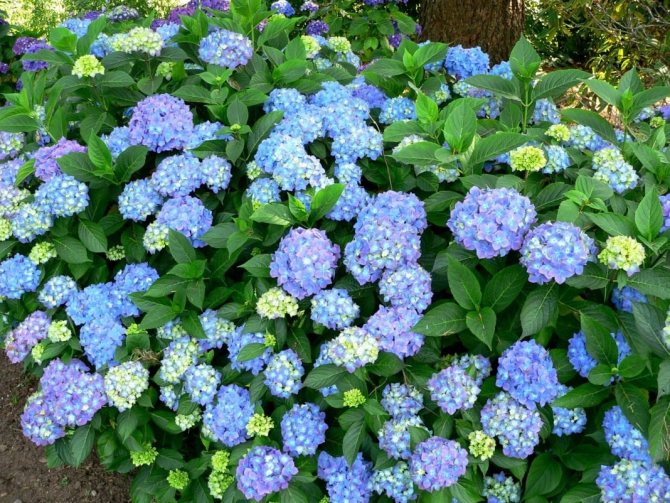

Large-leaved hydrangea (Hydrangea macrophylla).
Hydrangea paniculata (Hydrangea paniculata)
The natural range of the species is Eastern China, Korea, Japan, Sakhalin. Plants are about one and a half meters high. Green buds appear in mid-July, by the end of the month they turn white; flowering - from August throughout the fall; inflorescences - with a smooth transition from white to crimson and crimson with a purple tint. Panicle hydrangea has high winter hardiness. In autumn, pruning of faded inflorescences is recommended, in spring - sanitary and formative pruning.Famous varieties are Hydrangea paniculata ‘Kyushu’, ‘Pinky Winky’, ‘Grandiflora’.
Read our detailed article: Hydrangea paniculata - the return of a legend.
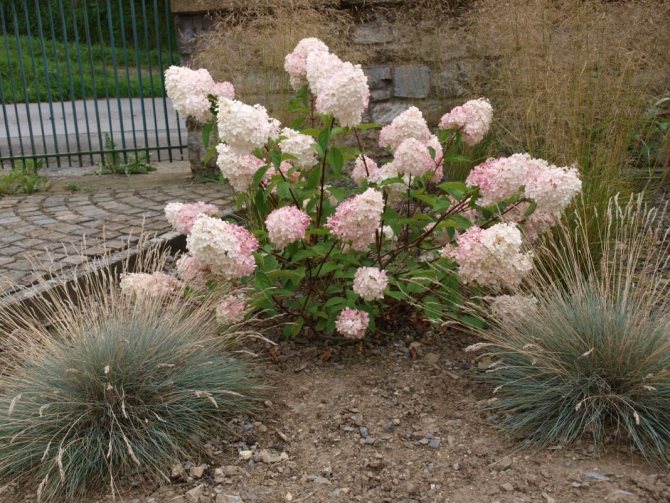

Hydrangea paniculata (Hydrangea paniculata).
Effect of pruning on flowering
Improper pruning is another factor that has a significant impact on the flowering of a garden or indoor hydrangea. In order not to ask the question: why the hydrangea does not bloom, it is necessary to properly cut it. Moreover, the concept of "correct" for each type of hydrangea individually.
So, in the spring, in the fall, only faded inflorescences are cut off so that they do not break under the weight of the snow. If the hydrangea did not bloom in the summer, then it is not necessary to cut it at all.
In the spring, the panicle hydrangea is pruned before the buds bloom, if you miss the pruning time, the development of the plant will be suspended so much that it will not bloom this season. When pruning, remove weak and small shoots, as well as shoots that are frozen in severe frosts. Annual shoots are cut so that 3-4 pairs of buds remain on them.
Large-leaved hydrangea blooms only on the shoots of last year, more precisely, on young branches that grew on last year's shoots. And if you remove last year's shoots when pruning, there will be no flowering. Pruning large-leaved hydrangeas is carried out only to remove damaged stems and last year's inflorescences.
Groundcover hydrangea blooms on young shoots this year. Pruning it consists in shortening too long young branches, due to which the bush becomes more branched and blooms more profusely.
From this we can conclude: in order for the hydrangea to bloom, it is pruned taking into account its species characteristics, otherwise you may never see its flowering at all. Do not forget that the hydrangea growing in the wild blooms without any pruning, so you should not get too carried away with this operation at home.
Planting hydrangeas
Before planting tree hydrangea cuttings in early April, it is necessary to dig a hole 50 cm in diameter and 60-70 cm deep. It is also necessary to add 20 g of urea and 30 g of potassium sulfate and superphosphate.
Repeat a similar complex feeding after 2 years. Top dressing with mineral fertilizers or manure can be carried out at the beginning of growth, during the period of bud formation and 1-2 times in the summer in smaller doses.
Plants need to be planted at a distance of about 150 cm from each other. You should not place the plant next to trees, as they actively absorb moisture from the soil. No shelter is required for the winter. Thanks to the powerful root system, in the event of freezing, the plant is restored to its previous state. It begins to bloom in 4-5 years.
Seedlings of hydrangea paniculata are planted in a permanent place at the age of 4-5 years. To do this, prepare a hole 35-40 cm deep, 50 x 70 cm wide. And for a free hedge, a meter strip is dug. The distance between adult plants should be up to 2.5 m, but in order to have a “bouquet” earlier, the pits are marked every 0.7-1 m, and after a few years the group is thinned out.
In the northern regions, it is better to plant hydrangea in spring, in more southern regions - in spring and autumn. The roots are slightly shortened, and if it happens in the spring, then all the annual shoots, leaving 3-4 pairs of buds on each. The plantings are mulched with peat, a compost layer of 5-8 cm. From autumn they are fed with mineral fertilizers, and in early spring - with a solution of urea at the rate of 18-20 g per bucket, 2-3 buckets per plant.
Large-leaved hydrangea is relatively photophilous, but it can be planted in light partial shade, but the less light, the later flowering occurs and the fewer inflorescences.The soil is preferably slightly or moderately acidic (pH 5.5); one of the compositions: leaf, sod land, peat and sand in a ratio of 1: 1: 1: 1. On alkaline soil, hydrangea suffers from chlorosis (the leaves begin to turn yellow). To avoid chlorosis, watering with a solution of salts containing iron is carried out once every 10 days.
Depending on the acidity of the soil, you can change the color of large-leaved hydrangea flowers. With a slightly alkaline reaction of the medium, they are pink, with an acidic reaction, they change color to blue or blue. To obtain blue and blue inflorescences, it is necessary to add iron salts and alum to the soil every two weeks: 3-5 potassium alum or ammonium-potassium alum per 1 liter of water. For one plant, 2 liters of such a solution are needed.
To accelerate flowering, the plant is sprayed twice with an aqueous solution of gibberellins with an interval of 4-7 days at a concentration of 50 mg / l. Then the hydrangea blooms 2-4 weeks earlier. This technique also increases the decorative effect of plants. The flowers become larger, and there are more of them. Plants are processed when the inflorescences reach 2-4 cm.
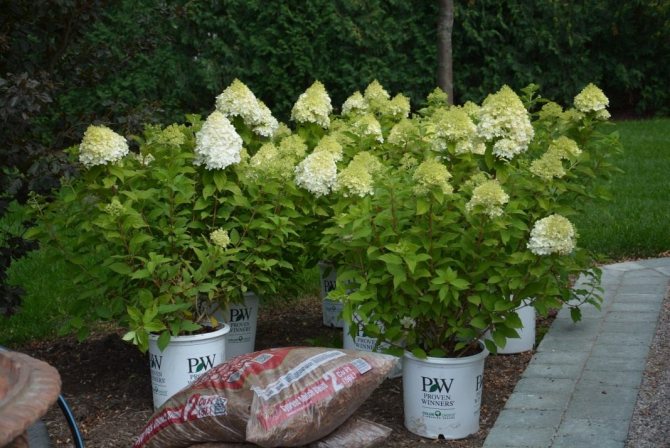

Planting hydrangea paniculata.
Variety selection
Hydrangea paniculata: the best varieties for the Moscow region
When choosing a type of panicle hydrangea for planting, it is important to pay special attention to the variety, the plant's compliance with the climatic zone, planting and care requirements.
A variety bred for cultivation in the southern regions of Russia, when planted in the northern regions, will either bloom late or not bloom at all.
Proper and proper care helps to grow a healthy plant, and the accelerated growth of the root system promotes abundant and luxuriant flowering, regardless of the variety and color of the hydrangea.
Features of growing hydrangeas
Hydrangea grows quickly, thermophilic, demanding on soil and moisture, does not tolerate lime. It is tolerated with slight shading, low frost resistance (up to -18 ° C).
Easily propagated by dividing the bush and green cuttings. In Russia, large-leaved hydrangea grows in open ground only in the south. When cultivated in a greenhouse or in a room at the very end of the growing season, when the hydrangea begins to shed its leaves, the shoots should be cut shortly. In winter, during the dormant period, the plants are kept in a cool, but non-freezing room (+5 ° C), and at the end of winter, when the buds swell, they are transferred to a warmer and brighter room, but without direct sunlight. Also, this species can be cultivated as a container culture, which is kept outdoors only in the summer season.
Recently, with the development of agricultural technology and climate warming, large-leaved hydrangea began to be cultivated in the open ground of central Russia. In a garden hydrangea, inflorescences are formed on last year's shoots. Therefore, the main problem is to keep them whole so that the flower buds do not freeze and do not spill out. Shelter methods are the same as for roses.
Among the varieties of garden hydrangea, there are more winter-hardy varieties and those that can be grown in central Russia only with the introduction of plants for the winter indoors. Even relatively winter-hardy varieties of garden hydrangea, due to the peculiarities of the microclimate, can not grow and bloom in all areas.
Large-leaved hydrangea bushes tolerate frost better if they received a sufficient amount of moisture in the fall. Flowers and leaves of large-leaved hydrangeas die even with weak night frosts, therefore it is recommended to cover them already in the second half of October. You can cover the bushes from short-term frosts with a covering material and a greenhouse film, always in two layers. For the winter, the plants are huddled at the base with peat, the branches are bent to the ground and covered with dry leaves, spruce branches.
Read our detailed material: Rules for growing large-leaved hydrangeas.
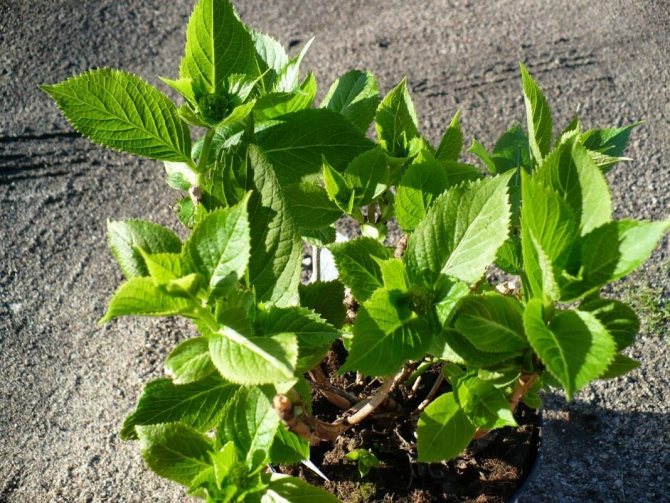

Planting hydrangeas. <>
Why doesn't the garden hydrangea bloom?
Hydrangeas or garden hydrangeas are amazingly beautiful and lush-flowering plants that look very impressive in summer cottages and flower beds.These beauties can reach a height of one and a half meters! Both a single hydrangea and a composition of several bushes in the garden will always delight you with magnificent inflorescences of different colors. This is favored not only by the variety of shades of spherical and corymbose inflorescences, but also by the shape of the flowers themselves. In the center of the flower ball there are female-type flowers, and larger and brighter male flowers, which consist of four or five enlarged sepals, decorate the edges. In addition, this plant can be not only a shrub, but also a small tree, and even a liana. The possibilities for designing a plot with hydrangea are endless!
Usually the hydrangea bloom period lasts from late spring to early autumn. But sometimes gardeners who planted this plant a few years ago do not wait for the inflorescences to appear. It happens that hydrangea blooms poorly, and why is unknown.
Reasons for the lack of flowering
Before looking for reasons explaining why the garden hydrangea does not bloom, and deciding what to do, you need to know about some of the characteristics of the species. So, tree and panicle hydrangeas are very demanding on the conditions of detention. In addition, young plants will not form inflorescences until they gain strength, but this lasts for years. It is difficult to say exactly in what year after planting the hydrangea blooms, because the quality of the soil, and the level of lighting, and the regularity of watering matter.
In most cases, this plant does not bloom due to the fact that its root system is not yet sufficiently developed. If you bought a flowering bush, planted it on the site, and the flowering gradually faded away, do not be surprised. Unscrupulous sellers often use growth stimulants to make the hydrangea bloom. As a rule, for another two years after such a forced flowering, the plants do not release inflorescences, gaining strength.
The second reason is incorrect pruning of plants. Older varieties of large-leaved garden hydrangeas produce inflorescences at the top of the shoots that have grown in the past year. If you are not worried about covering the bush from frost for the winter and preparing it for winter, then these shoots will have to be removed due to freezing. It is quite natural that during the flowering season your hydrangea will not please with lush inflorescences. Moreover, it will not bloom for the next several years.
Shoot pruning should be done at the end of October. At the same time, several pairs of young buds are left on the shoots. In the spring, these young shoots are shortened again so that the flowering is more lush.
The laying of the buds of the garden hydrangea occurs in the fall. If frost hits at the beginning of spring, when they begin to wake up, they will freeze. It is not recommended to remove the shelter from the bush until the air temperature at night settles at -5 and higher degrees.
The homeland of hydrangeas is Central Asia, where the climate is different from the domestic one. When buying a plant in stores, look for varieties that are well acclimatized to our natural environment. The fact is that the thermophilic hydrangea may simply not have time to lay new flower buds in our short summer, therefore it will not bloom next year.
Providing garden hydrangeas with proper care, you will acquire an excellent decoration in the garden, and fragrant lush inflorescences will delight the eye for a long time. Let your hydrangea bloom as much as you like!
Related articles:
| A flower bed of stones with your own hands One of the main decorations of the personal plot are flower beds. Break them down to your liking using different plants: perennial or annual. And to give a complete look, they make a border, for example, a stone one, which gives a special naturalness. | Rose stock - planting and care The stock rose, despite the name, is not a rose, but belongs to the mallow family, which is why it is often called mallow.This is a beautiful plant, absolutely unpretentious to care for. In our article we will talk about growing mallow in the garden. |
| The care of gardeners in the fall is the preparation of perennial flowers and plants for winter. Proper care will determine whether the plant can survive the harsh winter and delight us next year. In our article we will talk about the autumn care of peonies. | Thanks to the huge number of clematis varieties bred by breeders, they alone can completely plant a site, achieving continuous flowering and the embodiment of any fantasies in landscape design. In our article we will tell you about the most popular varieties of these flowers. |
Soil for hydrangeas
For successful abundant flowering, fertile soils are needed. Hydrangea prefers clayey structural soil, grows on red soil, but does not like sandy soil. By the way, the color of the flowers becomes brighter in the panicle hydrangea growing on acidic soil, and on neutral soil it not only turns pale, but the whole plant has a hard time.
Therefore, if the soil on the site is not acidic enough, when planting, it is necessary to add brown peat, coniferous soil (spruce, or better pine half-rotted litter), sawdust. Ash, lime, chalk and other deoxidizers are contraindicated for all hydrangeas.
The root system is shallow. The roots are predominantly spread in width, and as a result, their border significantly exceeds the border of the crown. For normal life, they need moist soil. A good solution may be to plant ground cover plants in the near-stem circles, for example, saxifrage, various stonecrops.
Correct wintering
To protect the hydrangea from severe frosts, they begin to prepare it for winter in the fall. In an area with a warm climate, it will be enough to cut off the inflorescences and wrap the bush with agrofibre, and where the temperature in winter drops below 25 degrees, it is necessary to make a more reliable shelter.
Old inflorescences are cut off, the branches are bent to the ground and covered with peat, earth or sawdust. To do this, the bush is fenced with boards to make a box - branches are laid in it. In order not to bend them too much, first dry grass or leaves are placed on the ground, and branches are laid on this pillow. From above, the box is also nailed down with boards, after a heavy snowfall, it is additionally insulated with snow.
In the spring, with the onset of heat, the entire structure is removed, the plant is rejuvenated by pruning. In case of spring frosts, which are so frequent in Russia, the bush must be covered with agrofibre - if the flower buds, which have just begun to develop, freeze, the plant will not bloom this year.
Reproduction of hydrangea
Hydrangea is propagated mainly by herbaceous cuttings from basal shoots. Cuttings from lateral shoots give weaker plants, so they are avoided.
Cuttings of large-leaved Hydrangea grown in the house are carried out in February-March (even until April 15). Hydrangeas rooted in February-March can be grown in 4–5 stems, rooted later should be arranged in one stem.
Cuttings of large-leaved hydrangea grown in the garden are carried out from June to July inclusive, until the lignification of the shoots.
Depending on the availability of wiring material, cuttings are cut with 2-4 knots with a sharp and clean knife. Cuttings with small leaves root more successfully. You need to cut the cuttings just before planting them. You can not bring the cuttings to wilting. In the latter case, wilted cuttings should be immersed in water for a while. The leaves are shortened by one third or half. Cuttings are rooted in exploration boxes, on racks, in greenhouses. Good results are obtained when rooting cuttings in coniferous soil; cuttings do not cover with anything, but only often sprayed with water.
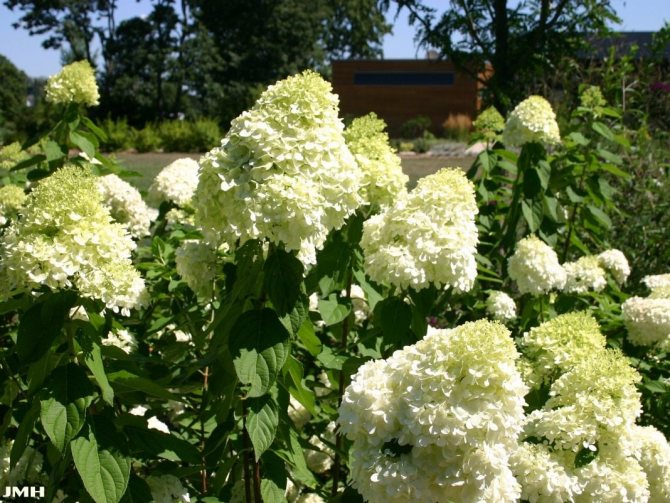

Hydrangea paniculata.
Cuttings for rooting are planted at a depth of 2 cm, but the cuttings of the lower leaves are not immersed in the soil. Planting distance 4-5 cm.After planting, they should be watered, bearing in mind that wilted cuttings of hydrangeas are difficult to restore turgor and take root worse.
Withering of cuttings is very often the cause of poor rooting. Hydrangeas should be shaded from bright sunlight. Some growers root hydrangea cuttings under glass, but this method often causes cuttings to rot.
The rooting temperature is maintained at about 14-17 ° C. A lower temperature lengthens the rooting period and therefore provides more opportunities for cuttings to rot. When cutting hydrangeas, cleanliness must be observed.
Rooted cuttings (this usually takes 15-20 days) are planted in boxes or on racks at a distance of 8 × 8 cm or in 7-9 cm pots. Growing hydrangeas in pots is uneconomical: more floor space and labor is required.
The soil for hydrangea cuttings should be acidic, consisting of swamp and compost soil. If the compost soil does not have acidity, then peat is used.
For white, pink and red hydrangeas, slightly acidic soil (pH 5-6) is recommended, for blue and lilac - more acidic (pH 4-4.5). With insufficient acidity, the leaves of the hydrangea turn yellow. To avoid this, the soil is watered with a weak solution of sulfuric acid (5 g per 100 l of water).
Planting plants in boxes or on racks makes it easier to care for the plants, they grow and develop better.
The cuttings are watered with water that does not contain lime, which neutralizes the acidity of the soil. You can not use not completely rotted manure, which can cause yellowing of the leaves. The same phenomenon can occur from an excess of lime in the soil, since with insufficient acidity of the soil, hydrangeas will not be able to absorb potassium, magnesium, iron.
It is advisable to prepare the soil in the previous fall or early winter so that the applied fertilizers can decompose sufficiently. For 1 m3 of soil add 2 kg of bone meal, 0.75 kg of potassium sulfate, 1.5 g of ammonium sulfate. Tomoslag and other fertilizers with an alkaline reaction are not recommended.
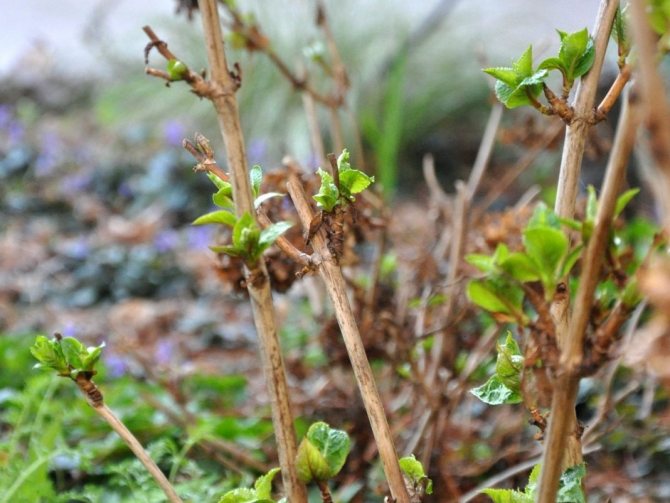

Hydrangea after spring pruning.
Rooted plants in the spring are fed every week with full fertilizer with a predominance of nitrogen. The temperature should be around 14 ° C. In May, boxes of hydrangeas are transferred to cold greenhouses.
Early varieties with a short growing period, which form flower buds faster, are pruned in the first half of June, and later varieties in May. Pruning is done over two pairs of normally developed leaves. These plants will have 3-4 shoots. Plants of late cuttings are not pruned, as they usually bloom with one cap. To get low indoor plants, you need to keep them from stretching. The cut tops of the plants are rooted to obtain single-stem plants.
Two weeks before or two weeks after pruning, the plants are planted in pots in which they should bloom. Elongated hydrangeas, when planted in pots, are planted deeper than they sat in order to reduce their height. Hydrangeas form roots even on lignified stems.
Single-stem plants are planted in pots with a diameter of 10-12 cm, and two-four-stem plants - in pots with a diameter of 12-14 cm. At first, plants in greenhouses after planting are shaded from bright sunlight. After rooting, the plants do not need shading: it can even lead to stretching of the plants.
Plants that are still weakly rooted in pots must be protected from heavy rains, so they are not immediately taken out of the greenhouse to the ridges of open ground. All weak shoots of hydrangeas are cut out, since only large flower caps are considered decorative.
Hydrangeas are moisture-loving plants, so they need to be watered and sprayed in a timely manner. To obtain ornamental plants, hydrangeas are systematically fed alternately with a solution of a mullein and a mixture of mineral salts.
Early varieties of hydrangeas finish their growth by August, so from this month they stop feeding and reduce watering, and then even dry them a little to ripen the buds. Late varieties finish growing a month later, after which they are also watered less frequently.
During the ripening of the buds, the plants are sprayed so as not to cause severe wilting. At the beginning of September, hydrangeas of early varieties are given pre-harvest feeding, which brings the flowering time closer. In winter, plants are best kept in cool greenhouses, basements, greenhouses. In case of insufficient light, the temperature in the greenhouse room should be about 2-4 ° C.
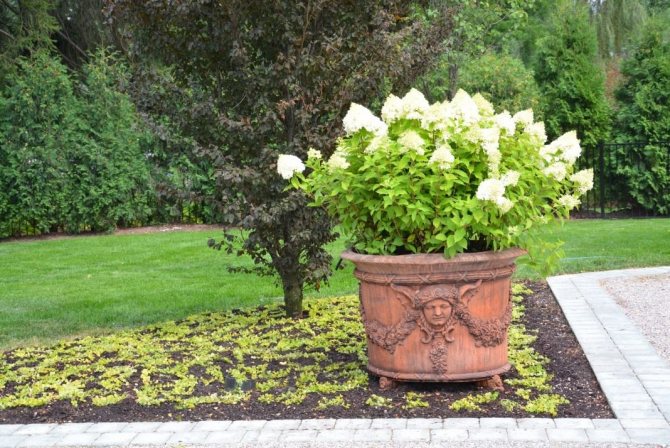

Hydrangeas in a street flowerpot.
What to do if hydrangea does not bloom?
Hydrangea captivates with its beauty and variety. Seeing a flowering plant, you will burn with the desire to have it on your site. Finally, when a dream has come true and the variety you like is planted in the garden or at home, disappointment and bewilderment comes - the hydrangea does not bloom! If you want to see a miracle of nature blooming with all the colors of the rainbow, follow the rules of agricultural technology. Check - what are you doing wrong?
Why hydrangea does not bloom: causes and their elimination
Hydrangea is a garden ornamental plant that requires special attention and care. Do not be discouraged if your bush has not bloomed - everything is fixable. How to make hydrangea bloom? The main thing is to establish the cause, we will look for it, and then eliminate it. There may be several reasons, but to lose flowering, one is enough.
Reason # 1. Abrupt change in microclimate
Buying a flower in a store and at the same time not knowing in what conditions it was grown, you get a pig in a poke. In greenhouse conditions, plant feeding and watering can be carried out by the drip method with feeding. The conditions for staying in a warm room are much different from natural conditions and a hydrangea transplanted into the ground gets stressed. It will take more than a year to expect flowering from it until complete acclimatization occurs.
How to speed up the adaptation process?
For the first two months, intensively feed the plant. Fertilizing during this period is necessary every 10 to 15 days. This will teach him to extract the necessary trace elements from the soil using the root system. It is best to use a ready-made product for feeding hydrangeas, azaleas or heather.
To avoid such problems, when purchasing a plant in a store, be interested in:
- where and in what conditions it was grown;
- choose a variety that is suitable for your climatic latitudes;
- transplant correctly, taking into account the characteristics of the acquired species.
Reason # 2. Weak root system
A young plant needs time for the root system to get stronger. Even when acquiring a blooming hydrangea, there is a chance that the transplant and last year's lush bloom is caused by stimulants.
Sometimes the reason why the hydrangea does not bloom is simple - the plant has not yet grown and you need to wait a little. Some varieties need 5 to 7 years to enter the flowering season.
How to develop a hydrangea root system?
Pruning will help in late March or early April. Rid the shrub from young shoots that take a lot of energy, remove weak and stunted shoots. In the fall, apply potash-phosphorus fertilizers to the soil. Mulch the root system. For this, it is good to use a coniferous litter.
If you decide to transplant a plant, then try to keep a clod of earth on the roots so that under new conditions it does not experience a sharp change in the structure of the soil. The soil should be light, loose, enriched with humus.
Reason number 3. Incorrect cropping
Adult perennial hydrangea varieties need pruning. It is made both in autumn and spring. If a plant variety blooms from last year's buds, then there is a chance that they are mistakenly removed. Having deprived the plant of young shoots with future inflorescences, you can not wait for a new flowering.Even with intensive growth, new buds do not have time to mature in a short summer.
How to prune a hydrangea correctly?
- A young plant that has not entered the time of flowering is not cut off. Do not require this variety, which bloom from buds that appear in spring, for example, microfila.
- In autumn, the bush is rejuvenated by removing old inflorescences. Cut off the cap of the peduncle under the base so that the nearest green shoots (leaves) remain on the branch. The foliage is removed, leaving the upper shoots.
- A spring haircut is done if the plant is caught in frost. Damaged branches are removed, if there are a lot of them, then the chances of flowering are reduced significantly.
- Pruning can be shorter, if there are several buds on the branch, then there will be fewer peduncles, but the caps will be larger.
In order for the hydrangea to bloom, it is necessary to follow the agrotechnical process, from planting to proper conservation for the winter. For example, a broad-leaved liana hydrangea will not bloom if it spreads along the ground, and not up (along a wall, tree).
Reason number 4. Frost
Broad-leaved varieties of hydrangea need to be well insulated, since they are afraid of winter frosts. With the wrong cover, the branches either break or freeze slightly. These should be removed in the spring, leaving only healthy and strong shoots.
Sometimes a well overwintered plant, improperly re-preserved in the spring, can suffer already from the morning spring frosts. First of all, young shoots with buds are susceptible to this, which begin to grow intensively as soon as they see the sun. So the hydrangea loses its valuable peduncles and remains without flowering caps.
How to properly cover a hydrangea for the winter?
- Depending on the variety, flowers are prepared for wintering in September. They do autumn pruning, removing the caps of the inflorescences, old dried branches, remove the remaining foliage (except for the apical ones). The bush is tied with twine so that the crown is less fragile and can withstand the weight of the snow. Pour mulch up to 8 - 10 cm.
- If the height of the plant is more than half a meter, and the branches are delicate and flexible, then they are bent to the ground, laying on a board and fix the position either with metal rods or wooden spears. The main thing is not to break them, you can lay a box on top or build supports that will save space around the bush.
- You can fold the formwork around from the boards, cover it with foliage and press it with spruce branches or cover it with non-woven material. If severe frosts are expected, then it is worth making the insulation more thorough by sprinkling the covered plant with an additional layer of earth or needles. For example, most tree and paniculate varieties can tolerate frosts up to 25 ° C well.
- In the spring, the insulation is removed for the day, and again covered at night if morning frosts are expected. Gradually, the branches dry out so that they do not snot under the shelter and adapt to the established weather. As a rule, not all hydrangeas are so demanding for the transition period, but for broadleaf species it is a necessary procedure.
In order to properly preserve the plant in winter - find out what variety you have, it is possible that it does not need to be covered. In mid-May, you need to carry out a comprehensive fertilizing with ready-made fertilizer for hydrangeas or rhododendrons.
Reason number 5. Watering disturbance
Hydrangea is not only a moisture-loving plant, but also dependent on water resources. If it is lost for some period of watering, then flowering can not be expected. Dried soil destroys the root system and it is difficult for it to restore the balance that a flowering bush needs. Therefore, the soil should never dry out.
How to keep humidity high?
- First of all, please note that some types of hydrangeas are recommended to be planted in a shaded or semi-shaded place, and, for example, paniculata are best placed in the sun. The most capricious in this regard are broadleaf varieties. Therefore, an incorrectly selected watering regime can affect the lack of flowering.
- You need to water it with either rain or warm settled water. Tap watering alkalizes the soil, and this leads to the growth of green mass, but not to flowering. A layer of mulch, at least 7 cm thick, helps to reduce the evaporation of moisture. Lack of acid leads to the absence of peduncles.
Add acidic substances to your irrigation water periodically. It can be vinegar (100 g per 3 L), citric acid (10 g per 3 L) and even kefir. Waterlogging of the soil is also detrimental to the roots, as well as drying out.
Reason number 6. Unbalanced feeding
A properly balanced feeding is essential for all plants, not just hydrangeas. Flowering species, when violated, are very moody and most often refuse to bloom. At the same time, greens, on the contrary, are raging beyond measure.
How to apply fertilizer correctly?
Each type of feeding affects certain periods of plant development, contributing to timely flowering. What you need to know about fertilizers:
- Nitrogenous - contribute to the intensive growth of green mass and the development of young shoots. They are introduced in late spring and early June.
- Potassium phosphate - essential for the flowering period. Submitted during the summer months.
- Phosphoric - help to stiffen twigs, strengthen the plant and contribute to a successful winter. They are introduced in late August or early September.
Apply ready-made dressings following the recommendations on the package. As a rule, they are balanced and do not require additional fertilizers, but they are also expensive for constant use. Therefore, use as needed, if required for your soil type. Complex feed Pokon and Florena are good stimulants for hydrangea flowering.
What if specific varieties of hydrangeas are not blooming?
For the flowering of hydrangeas of any variety, the entire complex of agrotechnical care must be observed. The reasons listed above are relevant for all hydrangas, but each of them has its own peculiarity that must be taken into account. Let's list the main types of plants for which one of the factors is the most vulnerable:
- Hydrangea paniculata - requires a particularly careful balance of feeding and a lot of light. It should not be forgotten that this species begins to bloom in the 6-7 year of planting.
- Treelike hydrangea is one of the most unpretentious plants, if it does not bloom, then most likely it does not have enough watering or the soil composition does not meet its needs.
- Broad-leaved hydrangea is very sensitive to frost, therefore, requires careful shelter for the winter and early spring for the night period. It is better to transfer autumn pruning to spring - otherwise, you can damage the kidneys. Or not do it at all.
- Home hydrangea is demanding on the temperature regime, if in the apartment the differences between summer and winter are different, then this can cause the lack of flowering. The optimum temperature for normal growth is 20 ° C. It is possible that a dormant period was not organized for the plant.
Top dressing hydrangeas for good flowering
For flowering garden plants, top dressing is necessary. Hydrangea is no exception and needs special care - the abundance of flowers requires a full set of trace elements, and if the hydrangea does not bloom, then the reason may be precisely the lack of feeding.
Ready dressing
- One of the best in terms of composition is considered to be a complex feeding Pokon (Pokon).
- For paniculate varieties - Agrecol (Agrecol). This preparation contains nitrogen, potassium oxide, aluminum.
- The preparation Biopon (biopon) is rich in microelements - it contains nitrogen, phosphorus, potassium, magnesium. Serves for the formation of large buds and increases the plant's resistance to cold and disease.
Organic
You can improve the composition of the soil with the following additives:
- pine needles (better fallen);
- slurry (preferably from chicken droppings);
- sulfur (teaspoon per 1 bush).
Hydrangeas are contraindicated in ash, chalk, lime.The introduction of these substances into the soil will slow down the development of the plant and exclude flowering, although the green mass will grow.
Chemicals
- Urea - applied in the early spring (first feeding);
- Potassium sulfate - applied from spring to late summer, during the flowering period - required;
- Superphosphate - used, like potash fertilizers, during the budding period.
The lack of a particular substance is determined by the composition of the soil and the external state of the plant, in accordance with this, it is fed 1-2 times a month. They stop applying fertilizers from the moment of autumn pruning.
Winter care for hydrangeas in greenhouses
In order for the hydrangea to bloom in December-January, it has been provided with additional electric lighting since October. Additional illumination of hydrangeas greatly brings the onset of flowering.
Hydrangeas are placed under lamps with rudimentary buds and give additional lighting in winter for 8-10 hours. The best results are observed under night lighting. It speeds up flowering by 7-20 days. Daylight has less effect.
Under the condition of good natural light in the greenhouse, the earliest suspension of growth is produced in November-December for flowering only in early March. For this, early varieties with well-ripened buds are used. With a lack of light, the plants are grown at a relatively low temperature of about 10 ° C, which lengthens the flowering period.
To accelerate the flowering of hydrangeas, warm baths are used: the plants are kept in water at a temperature of 35 ° C for 12 hours. After the bath, the hydrangeas are placed in greenhouses with a temperature of 15-16 ° C. Good results are also obtained by spraying plants twice at a temperature of 12-14 ° C with heteroacusin (100 mg of heteroacusin per 1 liter of water).
With the appearance of leaves, hydrangeas begin to water more. On sunny days, the temperature in the greenhouse can rise to 20 ° C. At this time, care must be taken to ensure that the plants are sufficiently well supplied with moisture. In a greenhouse, hydrangeas should stand freely, not shading each other.
When hydrangea buds appear, they are weekly fed alternately with mullein infusion and a solution of a mineral mixture with a predominance of nitrogen. The soil surface in pots should be loosened. When flowers form, hydrangeas are tied to pegs.
The whims of a home flower
Sometimes indoor hydrangea does not bloom, growing in favorable conditions. What is the reason, and what to do in this case? Let's start from afar - in the fall, indoor hydrangea can completely shed its leaves and retire. At this time, it is taken out into a dark, cool room, watering is reduced, carrying out them only so that the roots do not dry out and with the beginning of spring the plant begins to grow and bloom again.
At the end of winter, indoor hydrangea is taken out into a bright and warm room, they begin to water and feed well. In this case, you should not put the flower pot in the direct rays of the sun - the hydrangea prefers coolness and diffused light. If the temperature in the room is too high, they try to create special conditions for the hydrangea - they remove it away from the window and heating appliances, often ventilate the room without exposing the flower to drafts. Hydrangea does not like sudden changes in temperature; this feature must also be taken into account.
Soon, new shoots will begin to grow from the roots, on which inflorescences are formed. If there are too many shoots, some of them are removed, leaving 3-4 of the strongest and largest. The remaining stems are fed with mineral fertilizers. Sleep coffee is a good fertilizer for hydrangeas, which is scattered over the soil in a pot.
Every 3-4 years, the hydrangea is transplanted to a new place, for this they make a soil mixture with an acid reaction from peat, needles, leaf and sod land. You can use ready-made soil for azaleas by adding some needles to it.
Hydrangea is a popular decorative flower among gardeners. It belongs to the category of capricious cultures.Errors in growing technology lead to a lack of flowers. There are several reasons why the plant does not bloom. It is important to diagnose them correctly and then eliminate negative factors.
How to increase the size of hydrangea inflorescences?
To obtain exhibition hydrangea bushes with large and abundant flowers, you can use the following method. Old hydrangeas, cut 25-30 cm from the ground, are planted in the ground so that the root collar is covered with earth. For the winter, the plants bent to the ground are covered with spruce branches, dry leaves, etc. In the spring, old stems are cut to the ground. During the summer, multi-stemmed bushes are formed. Plants are watered abundantly. In the first half of summer, it is recommended to apply fertilizers. In August, hydrangeas are planted in the soil of pots or tubs. In the future, apply the usual care.
Within 5-6 years, you can grow tub hydrangeas with several dozen umbrellas. It is necessary to take large pots with an increase in the number of shoots: with one shoot - with a diameter of 10 cm, with two or three shoots - with a diameter of 12-13 cm, with a larger number of shoots, take pots with a diameter of 15-18 cm.
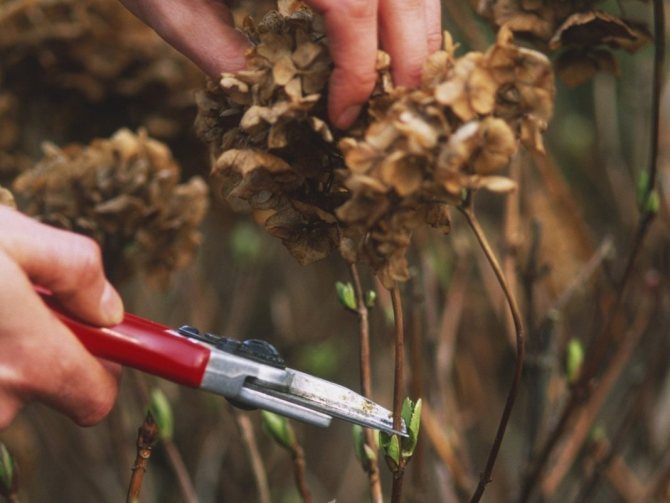

Spring pruning of last year's peduncles
Why does a flowering plant have small inflorescences?
There are many reasons why hydrangeas have small flowers. To determine the negative factors, the gardener should:
- Study the individual characteristics of the variety.
- Take into account the indicators of soil acidity, the place of cultivation of the bush.
- The presence of pests and diseases.
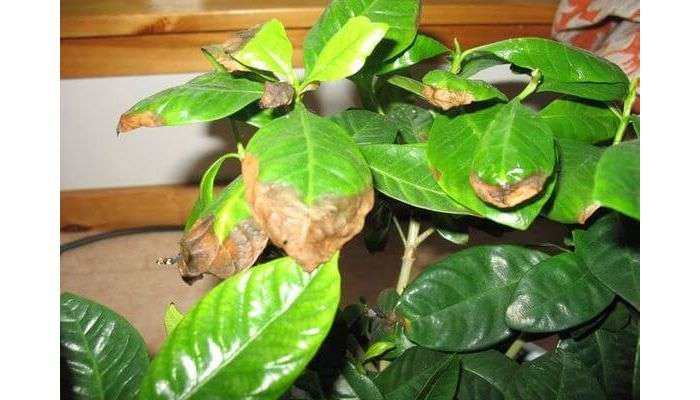

In hydrangeas, inflorescences become smaller most often due to improper cultivation of the bush:
- Choosing a bad place in the shade or under the scorching sun.
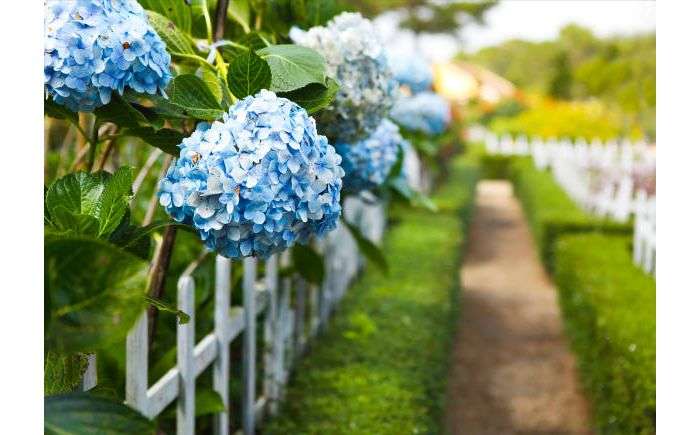

- Lack of moisture in the soil.
- Illiterate choice of nutritional formulations or refusal to use them altogether.
- Freezing of shoots and buds in winter.
The gardener should also remember about the adaptation period after the "move" of the plant. Having planted a seedling with an open root system, you should count on its long-term acclimatization. Hydrangea also gets sick after dividing the bush, transplanting to a new place.
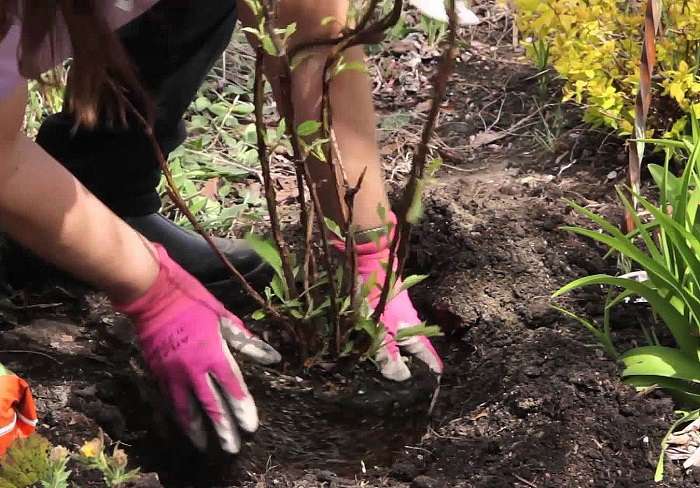

Why do hydrangeas have small inflorescences? Very often it is simply time to feed her. The plant is very demanding on nutritional composition, and therefore it is fed 4 times:
In early spring.Organics and complex microelements are introduced. For example, fertilizer "Kemira tsvetochnaya" has the necessary complex for a full start.
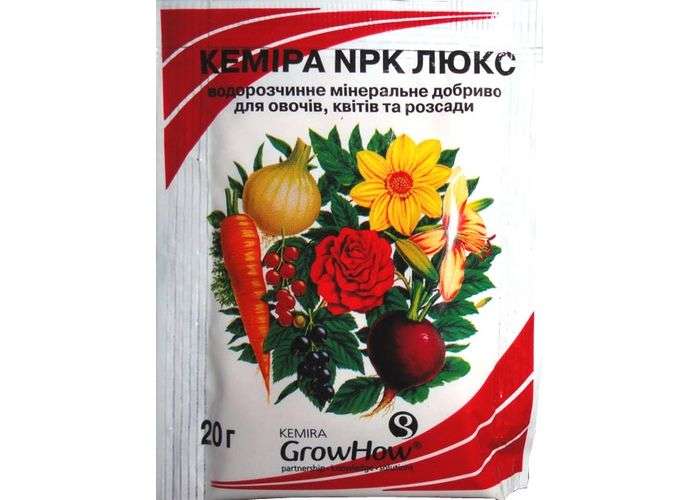

At the beginning of summer, at the time of bud formation, potassium and phosphorus (superphosphate, potassium sulfate) are added.
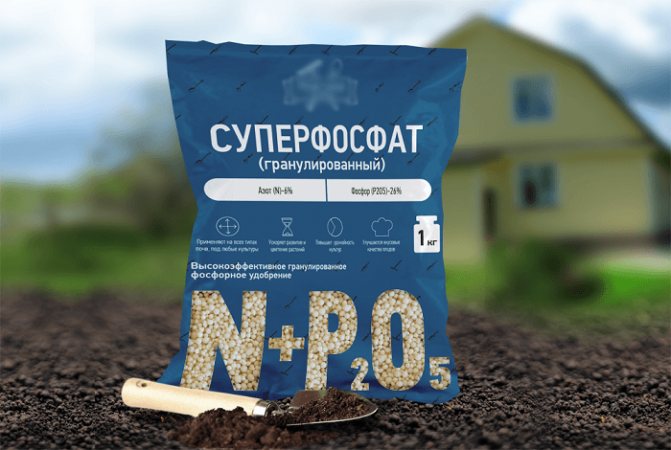

Important! Nitrogen is applied only in the spring. From July, fertilizers for hydrangeas with a high content of this substance should be excluded. It is nitrogen that promotes the development of green mass and inhibits the development of flowering caps.
Hydrangea care at home
Lighting. Hydrangea prefers bright, diffused light. Indoor hydrangea can be taken out into the garden in summer, gradually accustoming it to direct sunlight, and then, when the plants get used to it, the pots are dug into the ground and left until autumn.
Watering. Abundant from spring to autumn. Hydrangeas love when they are watered with some drying out of the earth in pots, but not allowing the entire earthy coma to dry out. Poorly tolerates hard water.
Air humidity. It is advisable to spray hydrangeas from time to time.
Top dressing. Fertilizer dressings are carried out with liquid mineral and organic fertilizers after watering. They are fed in summer and at the end of winter before flowering. After pruning, they do not feed until new shoots appear.
Undercutting. After flowering, half the length.
How the feeding should take place so that small inflorescences do not appear
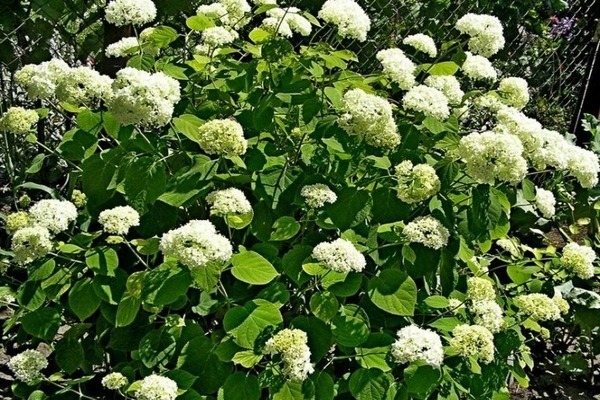

Fertilization must be done correctly and at the right time. If there are not enough nutrients in the soil or too much, it will harm the plant.It may not develop properly and may not bloom as expected. For example, by adding too much nitrogenous fertilizers, an active release of new shoots will begin. They will not have time to become stiff by winter and will die during frosts along with flower buds.
Do not feed plants with nitrogen-based fertilizers when the flower stalks begin to ripen. Such dressings are applied in the spring before the growing season begins. Next, fertilizers are applied based on potassium and phosphorus. And when preparing the plant for winter, you need to feed the soil with compost or rotted manure. Top dressing is carried out three times a season.
Diseases and pests of hydrangea
Spider mite
It affects the leaves from the underside, causing them to turn yellow and marbled, then dry and fall off. At the optimum temperature for the tick (29-31 ° C) and humidity (35-55%), its development cycle lasts 7-9 days. The mite covers the underside of the leaf with a brown spider web. It gives 12-15 generations per year. At low temperatures (10-12 ° C) and high humidity (80-85%), its activity is significantly reduced.
Control measures: spraying plants with thiophos (5-7 g per 10 l of water).
Downy mildew
It affects the leaves and stems of hydrangeas. Its first signs are the appearance on the leaves of oily, later yellowing spots, gradually darkening and increasing in size. A yellowish bloom appears on the bottom of the leaves, the same bloom can be found on young stems. The development of the disease is facilitated by a temperature of 18-20 ° C and high air humidity.
Control measures: treatment of affected plants with copper soap liquid (150 g of green soap, 15 g of copper sulfate per 10 liters of water). This liquid, harmless to plants, and its use in the early stages of development helps to completely get rid of the disease.
Chlorosis
A sign of chlorosis is the lightening of hydrangea leaves, only the veins on them remain dark. Plants growing on soils with a significant amount of lime are more susceptible to chlorosis. An excess of humus in the soil also leads to chlorosis.
Control measures: Pour 2-3 times with a solution of potassium nitrate at the rate of 40 g per 10 l of water and after three days - with a solution of ferrous sulfate, also 40 g per 10 l of water.
Aphids
In indoor conditions, when forcing plants, hydrangea can be affected by green leafy aphids.
Control measures: A good means of destroying it is to sprinkle plants twice with anabasine sulfate solution. For this, 15-20 g of anabazine sulfate is dissolved in 10 liters of water. This serves as a radical remedy in the fight against leaf aphids.
How nice it is to have such a colorful set of these wonderful flowers in the garden! But the best part is that hydrangea is not too difficult to care for and even in the fall can please you with an abundance of rich colors and shapes.
The main reasons why flowers with small inflorescences grow
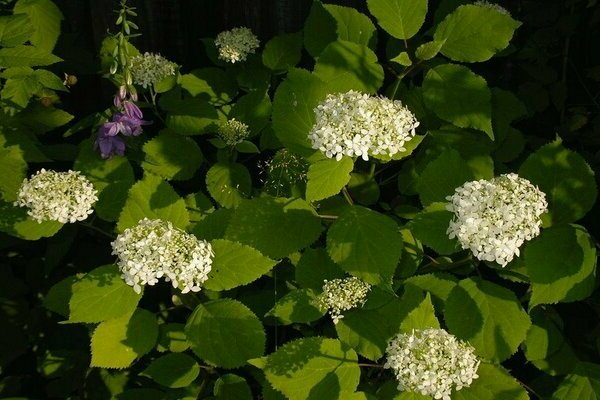

Even experienced gardeners face problems during the cultivation of hydrangeas. Sometimes, with seemingly good care, the flowering is still of poor quality. Why do small inflorescences appear?
In fact, there are many reasons, including very commonplace ones:
- If you systematically carry out incorrect pruning, then this leads to the fact that there are either no flowers at all, or very few of them.
- Poor root development affects flower formation. As a rule, this happens at a young age and it takes up to 5 years for the roots of the plant to get stronger and you can enjoy flowering.
- An improperly chosen planting site becomes a common cause of poor flowering.
- If moisture stagnates in the soil, or it is overdried, then the plant will not be able to delight with its beautiful flowers, on the contrary, it will begin to wither and die.
For good flowering, it is necessary to create the best conditions for the adaptation of a young seedling. A high alkali content causes not only poor flowering, but also death.In order to avoid this, it is necessary to regulate the level of acid in the soil.
Poor flowering can be caused by diseases and harmful insects. The plant is very resistant to them. But if you do not follow the agrotechnical rules, then the plants can get sick with chlorosis, powdery mildew, they will be attacked by aphids and spider mites.
Another way to deprive yourself of the pleasure of watching the bloom is to artificially stimulate the bloom.
If you choose the wrong variety and plant a plant that loves warmth in a region with long cold winters, then small inflorescences will be unambiguous.
No need to wait for flowering for 3 years after planting in the garden. There are few varieties that bloom in the first year of life.
It is important to know that in home-grown hydrangeas, the inflorescences will be smaller than those that grow near the house.
Reasons for late flowering
If the panicle hydrangea began to bloom late, then the reasons may be:
- ¾ Planting the plant in an unsuitable poor soil with high acidity, heavy, loamy, sandy.
- ¾ Lack of nutrients. The lack of fertilizing and fertilization manifests itself in the form of late flowering of the bush, regardless of the varietal affiliation and early maturity.
- ¾ Excess moisture.
- ¾ Damage by fungal infections (powdery mildew, late blight),
- ¾ Damage by pests: weevils, aphids, spider mites.
On a note! You can accelerate flowering with fertilizers. It is recommended to apply complex fertilizers suitable for the composition and variety of the plant. Fertilizers that have proven themselves positive are: Agricola, Fertika, Pokon, Green Boom, Flower Paradise.
At home, you can make the hydrangea bloom earlier in the following ways:
- ü Decrease the amount of watering, and then sharply increase. Such changes will provoke an artificial flowering onset.
- ü Make light pruning of the youngest shoots to speed up the growing season and make the hydrangea bloom earlier.
- ü Thoroughly loosen the soil, mulch it with organic matter, feed it with curdled milk (stir 3 liters of fresh curdled milk in 10 liters of water and water the roots abundantly).
To avoid frequent questions, when panicle hydrangea does not bloom (blooms late) what to do, it is important to strictly observe agrotechnological measures that contribute to the rapid development of the root system, timely and abundant flowering.
Answering questions
Hydrangea is a unique flower, and many inexperienced gardeners are asking the most common questions about the care and cultivation of a perennial plant.
We answer the questions:
- Hydrangea bush with inflorescences of different colors - how to achieve this effect? It is not difficult to achieve such an effect, feeding will help with this: To get a different shade on one bush inflorescences, you need to add ammonium-potassium alum diluted in water on one side of the bush (10 pcs per 2 liters). So one part of the hydrangea bush will acquire a blue color.
- For sky blue flowers feed the soil with iron salts or you can dig in an iron pipe for subsequent oxidation.
- To get a pink color flowers on a bush, it is necessary to pour a handful of lime into the soil on one side of the perennial.
Transplanting bushes
Incorrect transplantation very often becomes the reason why pink hydrangea does not bloom, but gives only foliage. Newbie flower growers can easily damage the root system, disrupting the usual plant metabolism.
Planting flowers
Also, the choice of too close or too spacious a container for growing indoor plants can lead to a slowdown in development and, as a result, the cessation of hydrangea flowering.
The choice of a suitable soil is also very important, because a sudden change in soil composition can negatively affect the general condition of the plants.
Post-flowering care
It is especially important to care for the hydrangea after flowering:
- bushes that are grown in the form of a pot culture, after the first frost (at the beginning or in the middle of October), are brought into a cool room - a cellar, basement;
- in garden specimens, all faded buds and non-viable areas are removed, then the near-stem zone is mulched with a thick layer of peat.
Hydrangea tree-like or paniculate can remain without shelter for the winter. These flowers are able to survive minor frosts in the southern zone. When grown in regions with a harsh climate, they are covered with burlap or roofing felt after the first frosts have passed. Low-growing young seedlings can be covered with a cardboard box.
With the arrival of spring, when the heat of the street stabilizes, the shelter is removed.
Problem solving methods
The very first condition is to determine what kind of hydrangea you are growing. Many of the features of care will depend on this. There are several main varieties of the plant: paniculate, tree-like and large-leaved.
Photo gallery: types of hydrangeas
In hydrangea, paniculate inflorescences have an elongated shape. panicle-like Treelike hydrangea is the most hardy and unpretentious Large-leaved hydrangea can change the color of inflorescences
Landing place
It is better to plant a hydrangea not in a sunny place, but in a light shade, on the east or west side of the site, so that the bush is protected by a shade from the midday sun.
Freezing of the kidneys
To prevent this from happening, the large-leaved hydrangea must be covered for the winter.
... To do this, you can first wrap the bush with lutrasil or spunbond, and cover it with dry leaves on top, having previously built a wire frame around the bush. Some varieties of this species need to be dug up for the winter and stored in the basement.
A wire frame will help to reliably cover a large-leaved hydrangea from frost
The other two species - treelike and panicle hydrangeas - are quite frost-hardy, they can do without shelter, mulching with peat and fallen leaves will be enough.
It is enough to mulch the trunk circle of a tree hydrangea with needles or fallen leaves for the winter
Pruning
In large-leaved hydrangea, pruning is advised to be carried out in the spring, while only dry inflorescences need to be trimmed, because flower buds are found at the ends of last year's shoots.
Large-leaved hydrangea should be trimmed carefully, removing only dried last year's inflorescences
Treelike and paniculate hydrangeas need to be cut harder, because it blooms on the shoots of the current year. This can be done in autumn and early spring. The pruning scheme is as follows: each shoot of this year is cut into 2-4 buds if the branch is growing strongly, and by 1/3 if the shoot is weak.
These species will benefit from the correct thinning of the bush, it contributes to the intensity of flowering. Dead shoots can be trimmed back to old wood. Shoots growing inside the bush are also removed.
Treelike and panicle hydrangeas need to be cut short enough
Video: how to trim hydrangeas correctly
Feeding
Usually during the season three feedings of hydrangeas are carried out.In order for the hydrangea to bloom, at the very beginning of growth, complex fertilizers are applied or fertilizers are combined with organic matter. Phosphorus and potassium are required to obtain abundant flowering.
You can use superphosphate or any other complex fertilizer containing these ingredients. The dosage is 1 tablespoon per 10 liters of water.
During the budding period, hydrangeas require potassium-phosphorus feeding
Reasons for the lack of flowering
This type of hydrangea reacts sharply to insufficient (improper) care, which is noticeable when the foliage grows excessively in the plant, the flower becomes much smaller in size, while it becomes more rare, not so lush, and the color of the inflorescences is faded.
The main reasons for the lack of flowers in paniculate hydrangea are as follows.
Improper watering
For successful growth and flowering, the plant needs regular watering. In hot weather, water should be 2 times a week, in dry, cool weather - once a week.
Watering is carried out with clean, settled water under the root, at least 10 liters of water for each hydrangea bush.
Lighting
Poor or no bloom can be caused by insufficient lighting. This is often seen in locations where natural sunlight is not fully available.
To solve this problem, you should establish additional lighting by other methods or transplant plants in places where there will be plenty of sunlight.
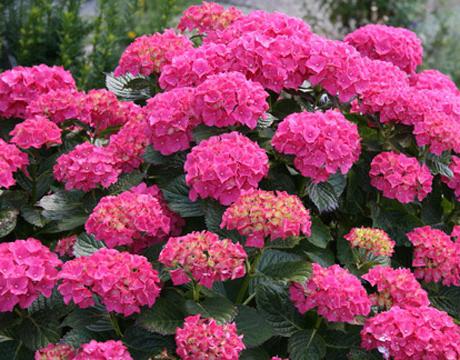

Pink flowers
Insufficient watering
Timely watering is equally important before and after flowering because garden hydrangeas do not respond well to lack of water. But hydrangeas are especially sensitive to lack of water when they bloom. Intense watering should be done not only in the spring after planting, but also in the summer to prevent these highly decorative flowers from drying out. Lack of moisture will negatively affect the appearance of both flowers and leaves.
To retain moisture around the bushes, it is recommended to spread mulch. Too long exposure of the hydrangea in the heat without proper watering can destroy the plant, or, at best, the bush will not bloom for several seasons until it is fully restored.
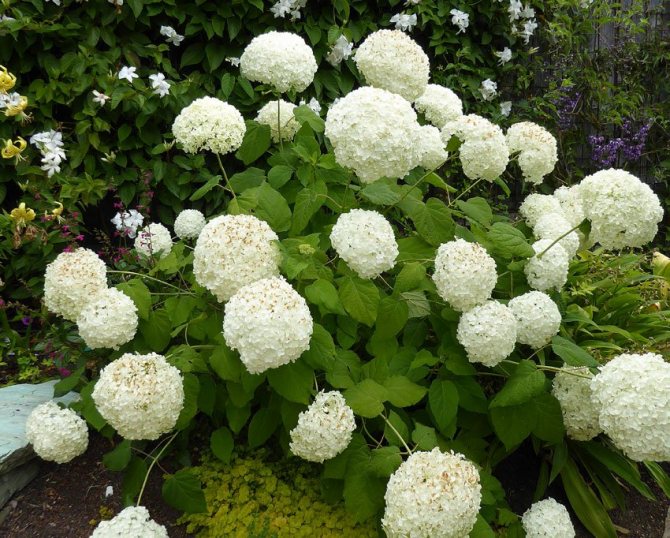

Treelike hydrangea can grow well in the sun, but it will need more frequent watering. <>
Key factors influencing the flowering of paniculate hydrangea
Landing
Hydrangea does not bloom if it is improperly planted:
- the requirements of the shrub to the quality of the soil are not met;
- the plant does not have enough lighting or it receives it in excess;
- the bush is not protected from drafts.
When growing panicle hydrangea, you need to take into account that this variety loves loose, slightly acidic soil, partial shade, areas of a flower bed, lawn or garden protected from the wind.
Pruning
There is no need to wait for the inflorescences if the flower shrub is incorrectly cut:
In early spring, last year's strong shoots were removed, on which inflorescences are formed;
In late autumn, all shoots of the shrub are cut by 2/3.
When pruning in late autumn, only dried inflorescences should be removed from the shrub. In the spring, it is necessary to check all shoots for any damage, remove diseased and unviable branches, as well as part of young pastures.
Wintering
Panicle hydrangea is not happy with inflorescences if the following mistakes were made in preparing it for wintering:
The plant hibernates without any shelter;
The bush is planted too close to the roof drain, which contributes to the drainage of cold water to the roots of the bush in the cold season, because of which the hydrangea either dies or subsequently spends energy on the formation of new roots and shoots.
Many breeders claim that the panicle hydrangea is frost-resistant and may well winter in the open field without additional structures. However, practice shows the opposite effect.The sharp amplitudes of temperatures observed over the past five years do not guarantee that the root system of the bush will survive.
Fertilizer
Another reason why the hydrangea refuses to bloom is the wrong feeding of the plant:
The proportions of nitrogen and mineral fertilizers are not observed;
Top dressing is applied randomly, without reference to the beginning and end of the active growing cycle.
In order for the hydrangea to bloom, flower growers perform three feeding cycles
:
- spring;
- summer;
- autumn.
The beginning of an active growing season requires strength to form new shoots and foliage; during this period, nitrogen fertilizers (potassium sulfate, urea) are introduced into the soil under the plant.
It is imperative to observe the proportion - 10 liters of water + 1 tbsp. l. potassium sulfate + 1 tbsp. urea.
The need for a young bush is 2 liters of top dressing, for an adult bush - 5 liters.
In May, the hydrangea must be fed with potassium-phosphorus solutions. This will allow the plant to get the nutrients it needs to create healthy buds. You can use a complex fertilizer or give preference to a solution of water with superphosphate in a proportion of 10 liters + 1 tbsp. l. superphosphate.
During the summer, when the active phase of flowering is observed, the plant needs stimulation. Hydrangea is fed up to three times a summer with fertilizers to enhance budding and duration of flowering of garden crops. The soil is acidified with citric acid (10 grams + 10 liters of water) or dairy product (1: 3).
In order for the plant to prepare for wintering - to strengthen the shoots and the root system, at the beginning of autumn it is fed with potassium-phosphorus fertilizers - 1 tbsp. potassium sulfate + 1 tbsp. l. superphosphate + 10 liters of water.
Reproduction
Propagating paniculata hydrangea by dividing a bush or planting purchased seedlings into the ground, you need to know that its young bushes in the first four to five years after planting spend energy on the formation of a strong root system and multiple shoots, therefore they do not bloom.
In order not to subsequently transship the plant, you should first carefully select a place for the hydrangea in the yard, flower bed or garden.
Watering
In search of an answer to the question of why the most beautiful hydrangea does not bloom, you should pay attention to the intensity of watering the bush.
Panicle hydrangea is very whimsical to watering, it does not tolerate drought, but at the same time, excess moisture negatively affects its development:
Watering the flower shrub should be warm, settled water.
The regularity of watering is 2 times a week.
Care requirements
Hydrangea grows and blooms well if it is properly cared for. Several conditions are required for the entire growing season.
- Systematic watering. This decorative and flowering culture loves moisture, so watering should be abundant - from 30 to 50 liters of water for each adult plant in a sultry summer. For young seedlings, 2 buckets are enough. The water is used warm and settled. In the presence of a mulch layer of peat, the frequency of irrigation can be reduced - up to 3 times per season, since mulch protects the soil from drying out.
- After each watering, the soil is loosened to a depth of 5 cm and weeds are removed, which drown out the bushes, take away moisture and nutrients from them.
- For a lush and long-lasting flowering, the hydrangea needs to be fed. The first top dressing is applied the next year after planting. Enough two dressings per season. Fertilizers are applied before and after flowering. Use a urea solution - 20 g per bucket of water. 1-1.5 buckets of solution are introduced under young seedlings; for adults, 3 buckets are needed. For nutrition after flowering, mineral fertilizers are used for decorative flowering plants. Additionally, in the summer, the bushes can be fed with slurry once. In 15 liters of water dissolve 1 liter of liquid substance. Consumption per plant - 1 bucket.
- Pruning has a positive effect on the growth, development and flowering of hydrangeas.This procedure is carried out in early spring at the initial stage of swelling of vegetative buds. The very first tree hydrangea is cut, which awakens earlier than other species. Shoots are cut at a height of 3-4 buds. Cut cuttings are not thrown away, since they make an excellent planting material for further propagation. For panicle hydrangea, a more gentle pruning is used - the shoots are cut off by a third of the length. All other species are not pruned, but only carry out a rejuvenating haircut, removing the fourth shoot growing inside the crown. Also, for all varieties, sanitary pruning is carried out to remove broken off shoots damaged by frost, diseases and winds. During the flowering phase, it is necessary to remove faded inflorescences in time to prolong the decorative effect of flowers and eliminate the risk of parasites and infections.
- Prevention of diseases and pests. To protect against infection, you should follow the planting scheme of bushes, use healthy planting material and sterile soil, keep the area clean and remove heavily affected specimens in time. For prevention, you can spray the flowers twice with Fundazol - in early spring and two weeks before flowering. For pests - spider mites, leaf aphids - use folk recipes - ash-soap solution or garlic infusion. In case of severe damage, they are treated with insecticides - Aktellik or Aktara.
Pruning bushes
Hydrangeas, like other shrub plants, need timely and correct pruning. It greatly affects the amount of foliage and the abundance of flowering. Improper pruning often becomes the reason why hydrangea does not bloom, but only gives foliage. This phenomenon is very common in large-leaved hydrangea varieties.
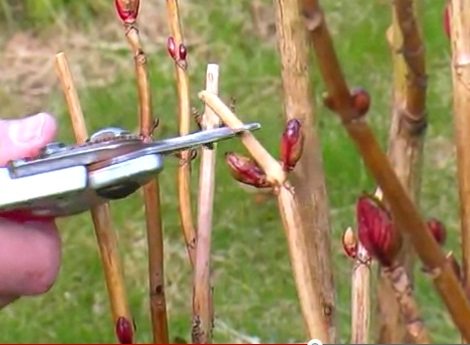

Pruning
Typically, most of the pruning is done in the spring after the snow has melted. In the fall, work on pruning hydrangea bushes is rarely left, only faded parts are removed. Spring pruning is done before foliage begins to form. Pruning methods may differ for each individual type of hydrangea.
Overview of characteristics
The decorativeness of hydrangea is appreciated by landscape designers and amateur flower growers. This perennial deciduous shrub has a beautiful crown and blooms for a long time. Grown in different climates, including cold regions.
Hydrangeas are represented by numerous varieties (over 800), which are grouped by type:
- tree-like;
- petiolate;
- large-leaved;
- ground cover;
- liana-shaped;
- serrated.
The shape of the flower depends on the species: panicle, ball, shield. Sizes can reach 25 cm in diameter, 30 in length.
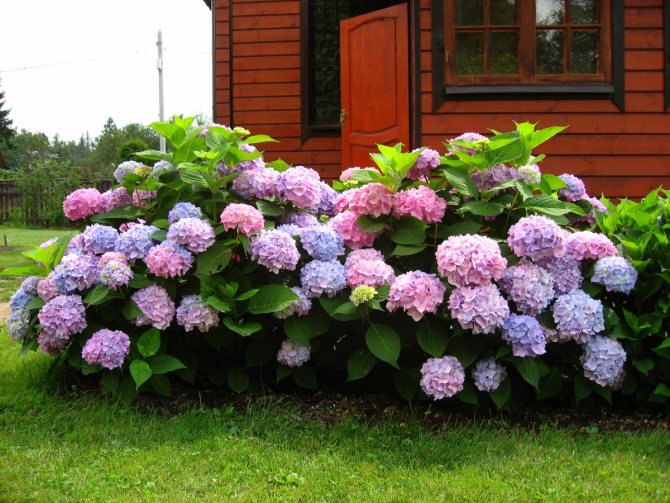

A spherical bud consists of many small buds. Photo:

